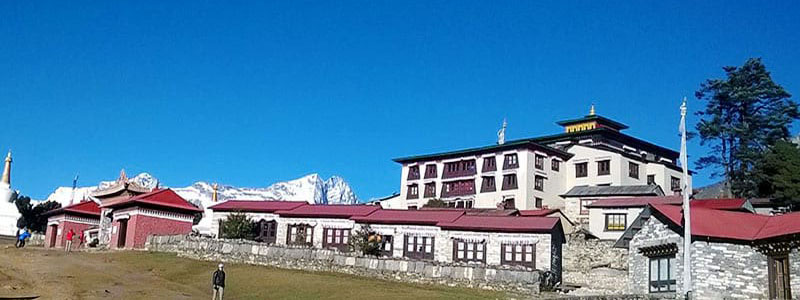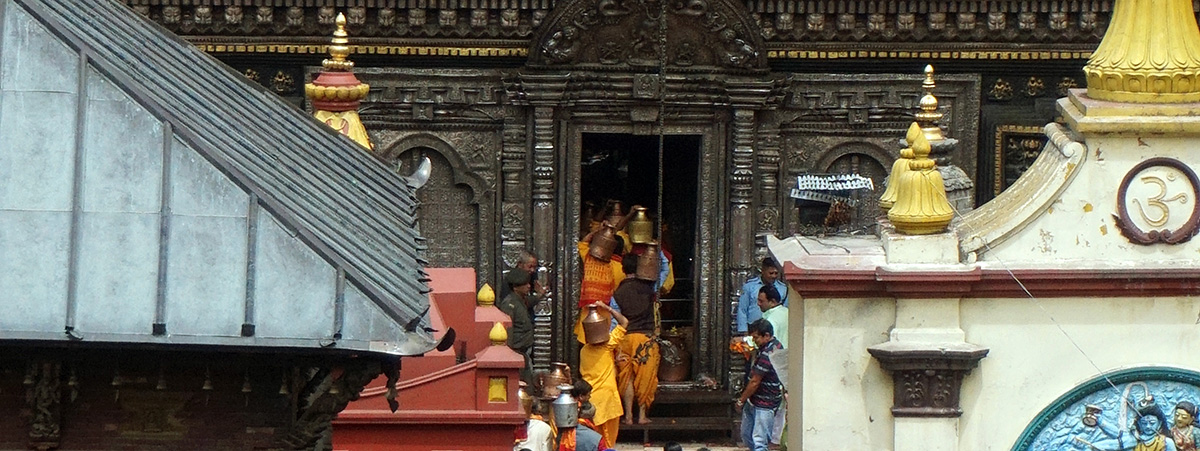
Nepal Heritage and Adventure tours

Nepal Heritage and Adventure tours
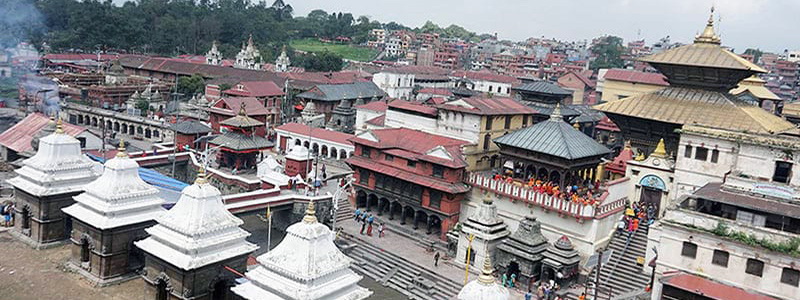
Pashupati: Lord Shiva is worshipped as Pashupati or Pashupatinath, the Lord of all living creatures. The temple of Pashupatinath is 6 Km east of Kathmandu. The site of Pashupatinath (Pashupat Kshetra) is one of the holiest places in Nepal for Hindus all over the world. Many Hindu Pilgrims come to Pashupatinath round the year. Hundreds of thousands of Hindu from all over the World make Pilgrimage on the day of Shivaratri (Night of Shiva in February). There are many temples of various Hindu Gods in the holy site. Guheswori temple is the most important among other temples. A walk from this temple to Aryaghat near Pashupatinath temple is very popular among non-Hindu tourists. Pashupatinath Temple area is one of the UNESCO World Heritage sites in Nepal. Entrance fee: Rs. 1,000.00; India: free

Pashupati: Lord Shiva wird als Pashupati oder Pashupatinath, der Herr aller Lebewesen, verehrt. Der Tempel von Pashupatinath liegt 6 km östlich von Kathmandu. Die Stätte Pashupatinath (Pashupat Kshetra) ist für Hindus auf der ganze Welt einer der heiligsten Orte in Nepal. Viele hinduistische Pilger kommen das ganze Jahr über nach Pashupatinath. Hunderttausende Hindus aus aller Welt pilgern am Shivaratri-Tag (Shiva-Nacht im Februar). An der heiligen Stätte gibt es viele Tempel verschiedener hinduistischer Götter. Der Guheswori-Tempel ist der wichtigste unter den anderen Tempeln. Ein Spaziergang von diesem Tempel zum Aryaghat in der Nähe des Pashupatinath-Tempels ist bei nicht-hinduistischen Touristen sehr beliebt. Das Gebiet des Pashupatinath-Tempels Gehört zum UNESCO-Weltkulturerbe in Nepal. Eintrittspreis: Rs. 1.000,00

Pashupati: El Señor Shiva es adorado como Pashupati o Pashupatinath, el Señor de todas las criaturas vivientes. El templo de Pashupatinath está a 6 km al este de Katmandú. El sitio de Pashupatinath (Pashupat Kshetra) es uno de los lugares más sagrados de Nepal para los hindúes de todo el mundo. Muchos peregrinos hindúes vienen a Pashupatinath durante todo el año. Cientos de miles de hindúes de todo el mundo hacen la peregrinación el día de Shivaratri (la noche de Shiva en febrero). Hay muchos templos de varios dioses hindúes en el lugar sagrado. El templo Guheswori es el más importante entre otros templos. Una caminata desde este templo hasta Aryaghat cerca del templo Pashupatinath es muy popular entre los turistas no hindúes. El área del Templo Pashupatinath es uno de los sitios del Patrimonio Mundial de la UNESCO en Nepal. Tarifa de entrada: Rs. 1,000.00; India: gratis

Pashupati: Lord Shiva è adorato come Pashupati o Pashupatinath, il Signore di tutte le creature viventi. Il tempio di Pashupatinath si trova a 6 Km a est di Kathmandu. Il sito di Pashupatinath (Pashupat Kshetra) è uno dei luoghi più sacri del Nepal per gli indù di tutto il mondo. Molti pellegrini indù vengono a Pashupatinath tutto l'anno. Centinaia di migliaia di indù provenienti da tutto il mondo effettuano il pellegrinaggio nel giorno di Shivaratri (notte di Shiva a febbraio). Ci sono molti templi di vari dei indù nel luogo sacro. Il tempio Guheswori è il più importante tra gli altri templi. Una passeggiata da questo tempio ad Aryaghat vicino al tempio di Pashupatinath è molto popolare tra i turisti non indù. L'area del tempio di Pashupatinath è uno dei siti del patrimonio mondiale dell'UNESCO in Nepal. Biglietto d'ingresso: Rs. 1,000.00;
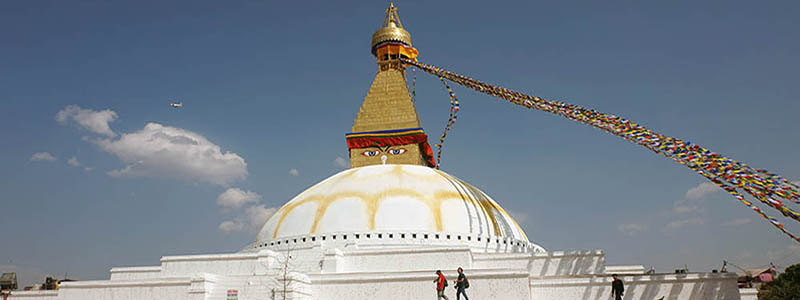
Bouddhnath: Bouddhnath Stupa is a holiest Lama Buddhist temple in Nepal at Bouddha, Kathmandu. The white Bouddhanath Stupa is perhaps the largest Stupa in the world. Bouddhnath is also the largest center for Tibetan Buddhism outside Tibet. The Stupa stands on a large mandala. The most striking of the Stupa is the Eyes at all four sides of the Stupa. The stupa is renovated after the 2015 earthquake. To know more about Tibetan Buddhism there are several Tibetan monasteries around Stupa. The most famous one is Kopan monastery, a 10 minute drive from the Stupa. Entrance fee: Rs. 400.00; SAARC: 100.00

Bouddhnath: Bouddhnath Stupa ist der heiligste Lama-buddhistische Tempel in Nepal in Bouddha, Kathmandu. Der weiße Bouddhanath Stupa ist vielleicht die größte Stupa der Welt. Bouddhnath ist außerdem das größte Zentrum für tibetischen Buddhismus außerhalb Tibets. Die Stupa steht auf einem großen Mandala. Das Auffälligste des Stupa sind die Augen auf allen vier Seiten des Stupa. Der Stupa wurde nach dem Erdbeben 2015 renoviert. Weitere Informationen zum tibetischen Buddhismus finden Sie hier mehrere tibetische Klöster rund um Stupa. Das berühmteste ist das Kloster Kopan, 10 Autominuten vom Stupa entfernt. Eintrittsgebühr: Rs. 400,00; SAARC: 100,00

Bouddhnath: Bouddhnath Stupa es un templo budista lama más sagrado de Nepal, situado en Bouddha, Katmandú. La estupa blanca de Bouddhanath es quizá la mayor estupa del mundo. Bouddhnath es también el mayor centro de budismo tibetano fuera del Tíbet. La estupa se alza sobre un gran mandala. Lo más llamativo de la estupa son los ojos en sus cuatro lados. La estupa está renovada tras el terremoto de 2015. Para conocer mejor el budismo tibetano hay varios monasterios tibetanos alrededor de la estupa. El más famoso es el monasterio de Kopan, a 10 minutos en coche de la estupa. Precio de la entrada: Rs. 400.00; SAARC: 100.00

Bouddhnath: Bouddhnath Stupa è il tempio buddista lama più sacro del Nepal a Bouddha, Kathmandu. Il Bouddhanath Stupa bianco lo è forse lo Stupa più grande del mondo. Bouddhnath è anche il più grande centro del buddismo tibetano fuori dal Tibet. Lo Stupa si trova su un grande mandala. Il più sorprendente dello Stupa sono gli Occhi su tutti e quattro i lati dello Stupa. Lo stupa è stato ristrutturato dopo il terremoto del 2015. Per saperne di più sul buddismo tibetano ci sono diversi monasteri tibetani intorno a Stupa. Il più famoso è il monastero di Kopan, a 10 minuti di auto dallo Stupa. Biglietto d'ingresso: Rs. 400,00; SAAR: 100,00
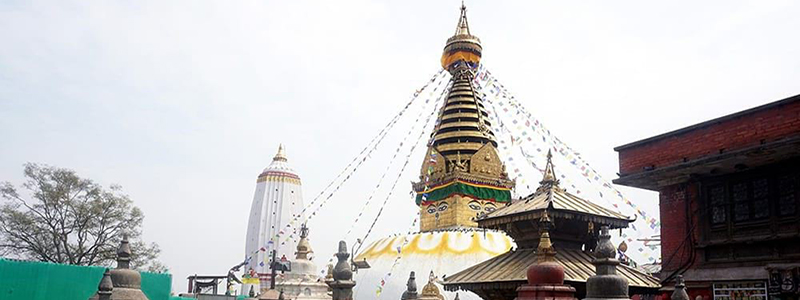
Swayambhunath: is an ancient temple complex on a small hill at the west of Kathmandu city. Swayambhunath is the most sacred among the Buddhist pilgrimage sites in Kathmandu valley. However for the Tibetan Buddhist it is second to Boudhanath. The Swayambhunath complex consists of a stupa, shrines, and temples, some dating back to the Licchavi period. The temple complex can be accessed by a long stairway with 365 steps or by a car road around the hill. Perhaps Swayambhunath hill is the best site for Kathmandu city view. Swayambhunath is also popularly known as monkey temple. Entrance fee: Rs. 200.00; SAARC: 50.00

Swayambhunath: ist ein alter Tempelkomplex auf einem kleinen Hügel im Westen der Stadt Kathmandu. Swayambhunath ist das heiligste unter ihnen die buddhistischen Pilgerstätten im Kathmandu-Tal. Für den tibetischen Buddhisten ist es jedoch zweitrangig nach Boudhanath. Der Swayambhunath-Komplex besteht aus einem Stupa, Schreinen, und Tempel, von denen einige aus der Licchavi-Zeit stammen. Der Tempelkomplex kann über eine lange Treppe mit 365 Stufen oder über eine Autostraße rund um den Hügel erreicht werden. Vielleicht Der Swayambhunath-Hügel ist der beste Ort für einen Blick auf die Stadt Kathmandu. Swayambhunath ist im Volksmund auch als Affentempel bekannt. Eintrittsgebühr: Rs. 200,00; SAARC: 50,00

Swayambhunath: Swayambhunath es un antiguo complejo de templos situado en una pequeña colina al oeste de la ciudad de Katmandú. Swayambhunath es el más sagrado de los lugares de peregrinación budista del valle de Katmandú. Sin embargo, para los budistas tibetanos ocupa el segundo lugar después de Boudhanath. El complejo de Swayambhunath consta de una estupa, santuarios y templos, algunos de los cuales datan del periodo Licchavi. Al complejo de templos se accede por una larga escalinata de 365 peldaños o por un camino de coches que rodea la colina. Quizá la colina de Swayambhunath sea el mejor sitio para contemplar la ciudad de Katmandú. Swayambhunath también se conoce popularmente como templo de los monos. Entrada: Rs. 200.00; SAARC: 50.00

Swayambhunath: è un antico complesso di templi su una piccola collina a ovest della città di Kathmandu. Swayambhunath è il più sacro tra i luoghi di pellegrinaggio buddista nella valle di Kathmandu. Tuttavia per il buddista tibetano è secondo a Boudhanath. Il complesso Swayambhunath è costituito da uno stupa, santuari, e templi, alcuni risalenti al periodo Licchavi. Al complesso del tempio si accede tramite una lunga scalinata di 365 gradini o tramite una strada automobilistica attorno alla collina. Forse La collina di Swayambhunath è il sito migliore per la vista della città di Kathmandu. Swayambhunath è anche popolarmente conosciuto come tempio delle scimmie. Biglietto d'ingresso: Rs. 200,00; SAAR: 50,00
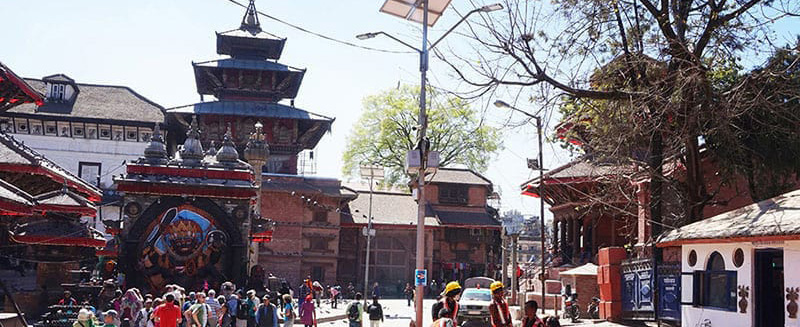
Kathmandu Durbar Square: is a UNESCO World heritage site. The durbar square complex is in the heart of old Kathmandu city. The complex site had been a place for royal palaces and temples since the Lichchhavi period (3 century A. D.). The main attractions are Hanuman Dhoka Palace, Basantpur palace, Gaddi Baithak, Kal Bhairav temple, Taleju temple, Living Goddess Kumari's house, big bell and big Nagada, and the pagoda called Kasthamandap from which the Kathmandu is derived. Unfortunately several buildings including Kasthamandap pagoda are destroyed by the April 2015 earthquake. Entrance fee: Rs. 1000.00; SAARC: Rs. 150.00

Kathmandu Durbar Square: ist ein UNESCO-Weltkulturerbe. Der Durbar-Square-Komplex liegt im Herzen der Vergangenheit Kathmandu-Stadt. Das komplexe Gelände war seit der Lichchhavi-Zeit (3. Jahrhundert n. Chr.) ein Ort für königliche Paläste und Tempel. Die Hauptattraktionen sind der Hanuman-Dhoka-Palast, Basantpur-Palast, Gaddi Baithak, Kal Bhairav-Tempel, Taleju-Tempel, Haus der lebenden Göttin Kumari, große Glocke und große Nagada sowie die Pagode namens Kasthamandap, von der aus das Kathmandu abgeleitet ist. Leider wurden mehrere Gebäude, darunter die Kasthamandap-Pagode, durch das Erdbeben im April 2015 zerstört. Eintrittsgebühr: Rs. 1000,00; SAARC: Rs. 150,00

Kathmandu Durbar Square: es Patrimonio de la Humanidad de la UNESCO. El complejo de la plaza Durbar está en el corazón de la antigua ciudad de Katmandú. El complejo albergó palacios y templos reales desde el periodo Lichchhavi (siglo III d. C.). Las principales atracciones son el palacio Hanuman Dhoka, el palacio Basantpur, Gaddi Baithak, el templo Kal Bhairav, el templo Taleju, la casa de la diosa viviente Kumari, la gran campana y la gran Nagada, y la pagoda llamada Kasthamandap, de la que deriva el nombre de Katmandú. Por desgracia, varios edificios, incluida la pagoda Kasthamandap, están destruidos por el terremoto de abril de 2015. Precio de la entrada: 1.000 rupias; SAARC: 150 rupias. Precio de la entrada: Rs. 1000.00; SAARC: Rs. 150.00

Kathmandu Durbar Square: è un sito patrimonio mondiale dell'UNESCO. Il complesso di Durbar Square si trova nel cuore del passato Città di Katmandu. Il complesso sito era stato sede di palazzi reali e templi sin dal periodo Lichchhavi (III secolo d.C.). Le principali attrazioni sono il Palazzo Hanuman Dhoka, Il palazzo Basantpur, Gaddi Baithak, il tempio Kal Bhairav, il tempio Taleju, la casa della dea vivente Kumari, la grande campana e la grande Nagada, e la pagoda chiamata Kasthamandap da cui deriva il Kathmandu. Purtroppo diversi edifici, tra cui la pagoda Kasthamandap, sono stati distrutti dal terremoto dell'aprile 2015. Biglietto d'ingresso: Rs. 1000,00; SAARC: Rs. 150,00
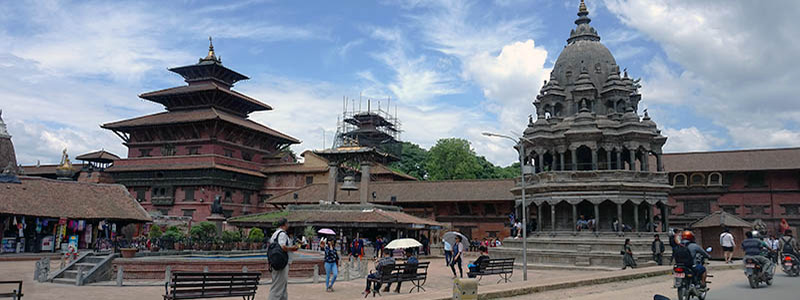
Patan Durbar Square: is within the old city Patan which is also called Lalitpur. The Patan Durbar Square is a UNESCO World Heritage Site. Main monuments in Patan durbar square are Royal Palace (now a museum), Krishna Mandir, Kumari Chowk, Tusha Hiti (Royal bath), Bhimsen temple, King Yogendra Malla's statue, big bell, etc. Nearby destinations are Mahaboudha, Kumbheswar temple, Hiranya Mahabihar, Ashok stupa, etc. Entrance fee: Rs. 1000.00; SAARC: 250.00

Patan Durbar Square: liegt in der Altstadt von Patan, die auch Lalitpur genannt wird. Der Patan Durbar Square ist ein UNESCO-Weltkulturerbe. Zu den Hauptdenkmälern am Patan Durbar Square gehören der Königspalast (heute ein Museum), Krishna Mandir, Kumari Chowk, Tusha Hiti (königliches Bad), der Bhimsen-Tempel, Statue von König Yogendra Malla, große Glocke usw. Nahe gelegene Ziele sind Mahaboudha, Kumbheswar-Tempel, Hiranya Mahabihar, Ashok Stupa usw. Eintrittspreis: Rs. 1000,00; SAARC: 250,00

Patan Durbar Square: se encuentra en la antigua ciudad de Patan, también llamada Lalitpur. Patan Durbar Square es Patrimonio de la Humanidad de la UNESCO. Patrimonio de la Humanidad de la UNESCO. Los principales monumentos de Patan Durbar Square son el Palacio Real (ahora museo), Krishna Mandir, Kumari Chowk, Tusha Hiti (baño real), el templo Bhimsen, la estatua del rey Yogendra Malla, la gran campana, etc. Los destinos cercanos son Mahaboudha, el templo de Kumbheswar, Hiranya Mahabihar, la estupa de Ashok, etc. Entradas: Rs. 1000.00; SAARC: 250.00

Patan Durbar Square: si trova all'interno della città vecchia di Patan, chiamata anche Lalitpur. La piazza Patan Durbar è a Sito Patrimonio dell'Umanità dell'UNESCO. I principali monumenti di piazza Patan Durbar sono il Palazzo Reale (ora un museo), Krishna Mandir, Kumari Chowk, Tusha Hiti (bagno reale), tempio Bhimsen, Statua del re Yogendra Malla, grande campana, ecc. Le destinazioni vicine sono Mahaboudha, il tempio Kumbheswar, Hiranya Mahabihar, Ashok stupa, ecc. Ingresso: Rs. 1000,00; SAAR: 250,00
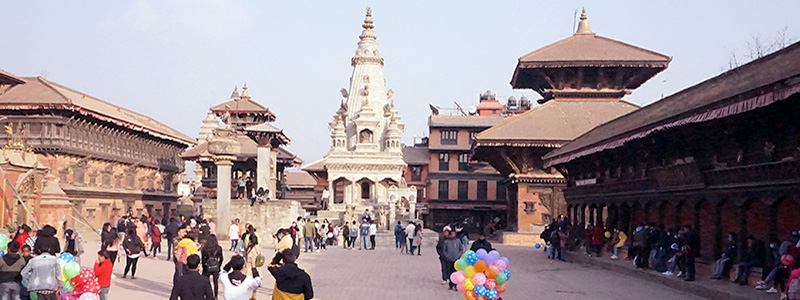
Bhaktapur Durbar Square: is in the old part of Bhaktapur city in Kathmandu valley. Bhaktapur city is also known popularly as Bhadgaon. The Bhaktapur durbar square is in front of an old Royal palace with 55 windows and a golden gate. It is a UNESCO World Heritage Site in the Kathmandu valley. The Bhaktapur Durbar square complex is a union of 4 squares, Durbar square, Taumadhi Square, Dattatreya Square, and Pottery Square. The National Art gallery in the palace, Dattatreya Temple, Bhairavnath temple, Nyatpole Temple at Taumadhi, etc. are main attractions. Some of the temples were ruined by the 2015 earthquake., etc. Entrance fee: US$ 15.00; SAARC: 500.00

Bhaktapur Durbar Square: befindet sich im alten Teil der Stadt Bhaktapur im Kathmandu-Tal. Auch die Stadt Bhaktapur ist im Volksmund bekannt als Bhadgaon. Der Durbar-Platz von Bhaktapur liegt vor einem alten Königspalast mit 55 Fenstern und einem goldenen Tor. Es gehört zum UNESCO-Weltkulturerbe im Kathmandu-Tal. Der Bhaktapur Durbar Square-Komplex ist eine Vereinigung von vier Plätzen: Durbar Square, Taumadhi Square, Dattatreya Square und Pottery Square. Die Nationale Kunstgalerie im Palast, Zu den Hauptattraktionen zählen der Dattatreya-Tempel, der Bhairavnath-Tempel, der Nyatpole-Tempel in Taumadhi usw. Einige der Tempel wurden durch das Erdbeben 2015 usw. zerstört. Eintrittspreis: 15,00 US-Dollar; SAARC: 500,00

Bhaktapur Durbar Square: se encuentra en la parte antigua de la ciudad de Bhaktapur, en el valle de Katmandú. La ciudad de Bhaktapur también se conoce popularmente como Bhadgaon. La plaza Durbar de Bhaktapur está frente a un antiguo palacio real con 55 ventanas y una puerta dorada. Es Patrimonio de la Humanidad de la UNESCO y se encuentra en el valle de Katmandú. El complejo de la plaza Durbar de Bhaktapur es una unión de 4 plazas, la plaza Durbar, la plaza Taumadhi, la plaza Dattatreya y la plaza de la Cerámica. La Galería Nacional de Arte del palacio, el templo de Dattatreya, el templo de Bhairavnath, el templo de Nyatpole en Taumadhi, etc. son las principales atracciones. Some of the temples were ruined by the 2015 earthquake., etc. Precio de la entrada: US$ 15.00; SAARC: 500.00

Bhaktapur Durbar Square: si trova nella parte vecchia della città di Bhaktapur, nella valle di Kathmandu. Anche la città di Bhaktapur è conosciuta popolarmente come Bhadgaon. La piazza Durbar di Bhaktapur si trova di fronte a un antico palazzo reale con 55 finestre e un cancello dorato. È un sito patrimonio mondiale dell'UNESCO nella valle di Kathmandu. Il complesso della piazza Bhaktapur Durbar è un'unione di 4 piazze, piazza Durbar, piazza Taumadhi, piazza Dattatreya e piazza delle ceramiche. La Pinacoteca Nazionale nel palazzo, Il tempio Dattatreya, il tempio Bhairavnath, il tempio Nyatpole a Taumadhi, ecc. Sono le principali attrazioni. Alcuni templi sono stati rovinati dal terremoto del 2015, ecc. Biglietto d'ingresso: US$ 15,00; SAAR: 500,00
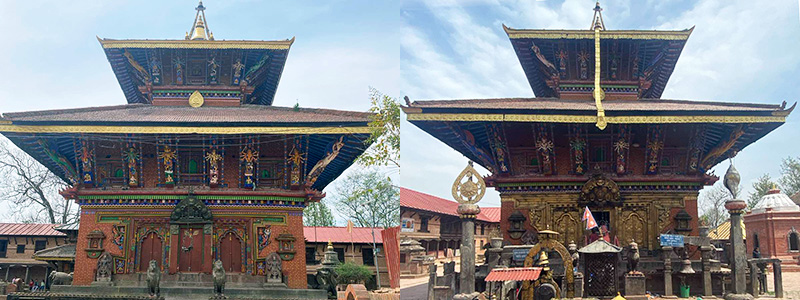
Changu Narayan Temple: is situated at the top of the hill surrounded by a forest of Champ (Golden Michelia) trees. Changunarayan temple is the oldest UNESCO World heritage site in Kathmandu valley. The temple is also believed to be the oldest temple of Nepal, and an ancient stone tap, on the way to Changu Narayan, is believed to have existed since the Lichhavi era. The temple is surrounded by sculptures and arts related to Lord Vishnu including Chakra, Sankha, Kamal, and Khadga all on top of stone pillars with Sanskrit inscription, which is considered to be the oldest inscription of Nepal. These pillars were erected by Lichhavi King Manadeva in 464 AD. Changunarayan hill is 20 kilometer east of Kathmandu city. Entrance fee: Rs. 300.00; SAARC: 100.00

Changu Narayan Tempel: liegt auf der Spitze des Hügels, umgeben von einem Wald aus Champ-Bäumen (Golden Michelia). Changunarayan-Tempel ist das älteste UNESCO-Weltkulturerbe im Kathmandu-Tal. Es wird auch angenommen, dass der Tempel der älteste Tempel Nepals ist, und ein alter Steinhahn auf dem Weg nach Changu Narayan, Es wird angenommen, dass es seit der Lichhavi-Ära existiert. Der Tempel ist von Skulpturen und Kunstwerken umgeben, die mit Lord Vishnu in Verbindung stehen, darunter Chakra, Sankha, Kamal und Khadga Spitze von Steinsäulen mit Sanskrit-Inschrift, die als älteste Inschrift Nepals gilt. Diese Säulen wurden 464 n. Chr. von Lichhavi-König Manadeva errichtet. Der Changunarayan-Hügel liegt 20 Kilometer östlich der Stadt Kathmandu. Eintrittsgebühr: Rs. 300,00; SAARC: 100,00

Templo de Changu Narayan: está situado en lo alto de la colina, rodeado de un bosque de árboles Champ (Michelia dorada). El templo Changunarayan es el más antiguo del valle de Katmandú declarado Patrimonio de la Humanidad por la UNESCO. También se cree que el templo es el más antiguo de Nepal, y un antiguo grifo de piedra, en el camino a Changu Narayan, se cree que existe desde la era Lichhavi. El templo está rodeado de esculturas y obras de arte relacionadas con el Señor Vishnu, como Chakra, Sankha, Kamal y Khadga, todas ellas sobre pilares de piedra con símbolos sánscritos. encima de pilares de piedra con inscripciones en sánscrito, consideradas las más antiguas de Nepal. Estos pilares fueron erigidos por el rey lichhavi Manadeva en el año 464 d.C. La colina de Changunarayan está a 20 kilómetros al este de la ciudad de Katmandú. Entrance fee: Rs. 300.00; SAARC: 100.00

Tempio Changu Narayan: è situato in cima alla collina circondato da una foresta di alberi Champ (Golden Michelia). Tempio Changunarayan è il più antico sito patrimonio mondiale dell'UNESCO nella valle di Kathmandu. Si ritiene inoltre che il tempio sia il tempio più antico del Nepal e un antico rubinetto di pietra, sulla strada per Changu Narayan, si ritiene che esista fin dall'era Lichhavi. Il tempio è circondato da sculture e arti legate al Signore Vishnu, tra cui Chakra, Sankha, Kamal e Khadga. cima di pilastri di pietra con iscrizione in sanscrito, considerata la più antica iscrizione del Nepal. Questi pilastri furono eretti dal re Lichhavi Manadeva nel 464 d.C. La collina Changunarayan si trova a 20 chilometri a est della città di Kathmandu. Biglietto d'ingresso: Rs. 300,00; SAAR: 100,00
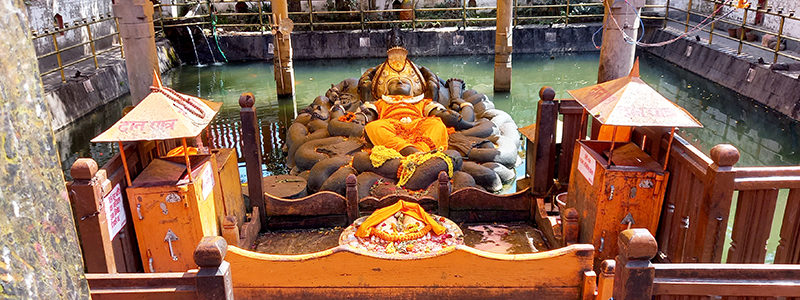
Budhanilkanth: Budhanilkantha Temple is at foot of the Shivapuri mountain at north Kathmandu valley. The main statue of Budhanilkantha is considered the largest stone carving in Nepal. The statue is carved from a single block of black basalt stone. The temple is also known as the Narayanthan (the Temple of Narayan). The temple is the second most visited temple in Kathmandu. The statue is 5 meters long and is placed in the middle of a pool of water, which is 13 meters long depicting the Lord Vishnu reclining on the coils of the cosmic serpent called Sheshanag. The statue is seven centuries old. It is interesting to note that there are no basalt stones in that part of the valley.

Budhanilkanth: Der Budhanilkantha-Tempel liegt am Fuße des Shivapuri-Berges im nördlichen Kathmandu-Tal. Die Hauptstatue von Budhanilkantha ist gilt als die größte Steinschnitzerei in Nepal. Die Statue ist aus einem einzigen Block schwarzen Basaltsteins geschnitzt. Der Tempel ist auch als Narayanthan (Tempel von Narayan) bekannt. Der Tempel ist der am zweithäufigsten besuchte Tempel in Kathmandu. Die Statue ist 5 Meter lang und steht in der Mitte eines 13 Meter langen Wasserbeckens, das die Statue darstellt Lord Vishnu liegt auf den Windungen der kosmischen Schlange namens Sheshanag. Die Statue ist sieben Jahrhunderte alt. Interessant ist, dass darin keine Basaltsteine enthalten sind Teil des Tals.

Budhanilkanth: El templo de Budhanilkantha está a los pies de la montaña Shivapuri, al norte del valle de Katmandú. La estatua principal de Budhanilkantha está considerada la mayor talla en piedra de Nepal. La estatua está tallada en un único bloque de piedra basáltica negra. El templo también se conoce como Narayanthan (el templo de Narayan). Es el segundo templo más visitado de Katmandú. La estatua mide 5 metros y está colocada en medio de un estanque de agua de 13 metros que representa al Señor Vishnu reclinado sobre las espirales de la serpiente cósmica llamada Sheshanag. La estatua tiene siete siglos de antigüedad. Es interesante observar que no hay piedras de basalto en esa parte del valle. parte del valle.

Budhanilkanth: Il tempio Budhanilkantha si trova ai piedi del monte Shivapuri, nella valle settentrionale di Kathmandu. La statua principale di Budhanilkantha è considerata la più grande scultura in pietra del Nepal. La statua è scolpita da un unico blocco di pietra basaltica nera. Il tempio è anche conosciuto come Narayanthan (il Tempio di Narayan). Il tempio è il secondo tempio più visitato di Kathmandu. La statua è lunga 5 metri ed è posta al centro di una vasca d'acqua lunga 13 metri raffigurante la Lord Vishnu adagiato sulle spire del serpente cosmico chiamato Sheshanag. La statua ha sette secoli. È interessante notare che non ci sono pietre di basalto in esso parte della valle.
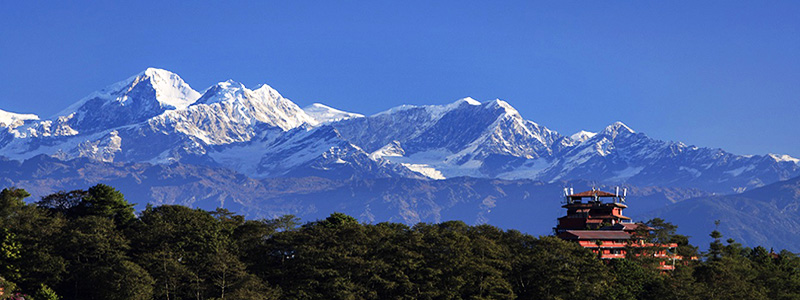
Nagarkot: Among many resort towns on the rim of Kathmandu valley Nagarkot is the most popular. Nagarkot is on the northeast rim and is the most visited resort town in the rim of Kathmandu valley. One can see a panoramic view of the Himalayas. Nagarkot is also the best point to see Sunrise and Sunset. Nagarkot is accessed by car or by one or two day hiking. Moreover one or two days hiking will give you a glimpse of trekking in Nepal.

Nagarkot: Unter vielen Ferienorten am Rande des Kathmandu-Tals ist Nagarkot der beliebteste. Nagarkot liegt am nordöstlichen Rand und ist der am weitesten entfernte besuchte einen Ferienort am Rande des Kathmandu-Tals. Man kann einen Panoramablick auf den Himalaya genießen. Nagarkot ist auch der beste Punkt, um Sonnenauf- und -untergänge zu beobachten. Nagarkot ist mit dem Auto erreichbar oder durch ein- oder zweitägiges Wandern. Darüber hinaus erhalten Sie bei einer ein- oder zweitägigen Wanderung einen Einblick in das Trekking in Nepal.

Nagarkot: Entre las numerosas ciudades turísticas del borde del valle de Katmandú, Nagarkot es la más popular. Nagarkot está en el borde noreste y es la ciudad turística más visitada del borde del valle de Katmandú. más visitada del valle de Katmandú. Se puede contemplar una vista panorámica del Himalaya. Nagarkot es también el mejor punto para ver el amanecer y el atardecer. A Nagarkot se accede en coche o haciendo senderismo de uno o dos días. Además, una excursión de uno o dos días te dará una idea de lo que es el senderismo en Nepal.

Nagarkot: Tra le molte località turistiche sul bordo della valle di Kathmandu, Nagarkot è la più popolare. Nagarkot si trova sul bordo nord-est ed è il massimo abbiamo visitato la località turistica ai margini della valle di Kathmandu. Si può vedere una vista panoramica dell'Himalaya. Nagarkot è anche il punto migliore per vedere l'alba e il tramonto. Nagarkot è accessibile in auto o con un'escursione di uno o due giorni. Inoltre un'escursione di uno o due giorni ti darà un assaggio del trekking in Nepal.
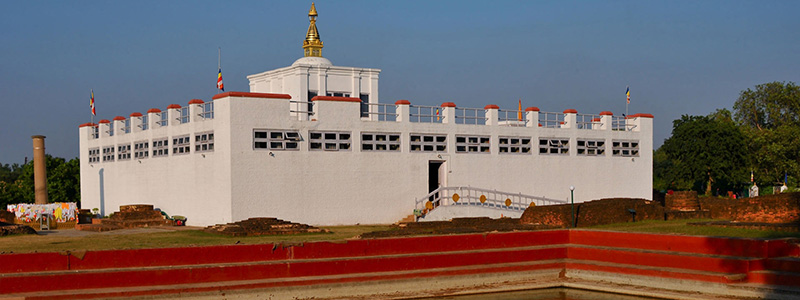
Lord Buddha as a prince named Siddhartha Gautam was born in Nepal at Lumbini. The birth site was then developed into a beautiful garden. The beautiful Garden in the Buddha's time still retains its charm and beauty and remains in the present day Lumbini Garden. Lumbini is about a 20 minute drive from Shiddarthnagar, a town in mid western Nepal.
Places of interest: Maya Devi Temple (birth site), Asoka Pillar, Archeological excavation sites, various Buddhist temples and monasteries
from Buddhist countries from all over worlds. Tilaurakot was then capital city. The archeological excavation around Tilaurakot is another destion.
Access: Lumbini is best accessed by car, Local bus, and Air (Kathmandu) and from India via Gorakhpur. Gautam Buddha International Airport
will be in operation soon for international flight connection.
Monument fee: RS. 250.00; SAARC: 150.00

Lord Buddha wurde als Prinz namens Siddhartha Gautam in Nepal in Lumbini geboren. Anschließend wurde der Geburtsort erschlossen in einen wunderschönen Garten. Der wunderschöne Garten aus der Zeit Buddhas hat noch immer seinen Charme und seine Schönheit bewahrt und ist im heutigen Lumbini-Garten erhalten geblieben. Lumbini ist etwa 20 Minuten Fahrt von Shiddarthnagar, einer Stadt im mittleren Westen Nepals.
Sehenswürdigkeiten: Maya-Devi-Tempel (Geburtsort), Asoka-Säule, archäologische Ausgrabungsstätten, verschiedene buddhistische Tempel und Klöster
aus buddhistischen Ländern aus aller Welt. Tilaurakot war damals die Hauptstadt. Ein weiteres Ziel ist die archäologische Ausgrabung rund um Tilaurakot.
Anfahrt: Lumbini ist am besten mit dem Auto, dem örtlichen Bus und dem Flugzeug (Kathmandu) sowie von Indien über Gorakhpur zu erreichen. Internationaler Flughafen Gautam Buddha
wird in Kürze für internationale Flugverbindungen in Betrieb genommen.
Denkmalgebühr: RS. 250,00; SAARC: 150,00

El Señor Buda nació como un príncipe llamado Siddhartha Gautam en Lumbini, Nepal. El lugar de su nacimiento se convirtió en un hermoso jardín. El hermoso jardín de la época de Buda aún conserva su encanto y belleza y permanece en el actual Jardín de Lumbini. Lumbini se encuentra a unos 20 minutos en coche de Shiddarthnagar, una ciudad situada en la mitad occidental de Nepal.
Lugares de interés: Templo de Maya Devi (lugar de nacimiento), Pilar de Asoka, excavaciones
arqueológicas, varios templos y monasterios budistas budistas de todo el mundo. Tilaurakot era entonces la capital. La excavación
arqueológica alrededor de Tilaurakot es otro destion.
Accesso: A Lumbini se accede mejor en coche, autobús local y avión (Katmandú) y desde la India
vía Gorakhpur. El aeropuerto internacional Gautam Buddha estará operativo en breve para la conexión de vuelos internacionales.
Tasa de monumento: RS. 250.00; SAARC: 150.00

Lord Buddha come principe di nome Siddhartha Gautam nacque in Nepal a Lumbini. Successivamente è stato sviluppato il luogo di nascita in un bellissimo giardino. Il bellissimo Giardino dei tempi del Buddha conserva ancora il suo fascino e la sua bellezza e si trova ancora oggi nel Giardino Lumbini. Lumbini ha circa 20 anni minuto di auto da Shiddarthnagar, una città nel Nepal centrale occidentale.
Luoghi di interesse: Tempio Maya Devi (luogo di nascita), pilastro Asoka, siti di scavi archeologici, vari templi e monasteri buddisti
dai paesi buddisti di tutto il mondo. Tilaurakot era allora la capitale. Gli scavi archeologici intorno a Tilaurakot sono un'altra destinazione.
Accesso: Lumbini è facilmente raggiungibile in auto, autobus locale e aereo (Kathmandu) e dall'India via Gorakhpur. Aeroporto internazionale Gautam Buddha
sarà presto operativo per i collegamenti aerei internazionali.
Tariffa per il monumento: RS. 250,00; SAAR: 150,00
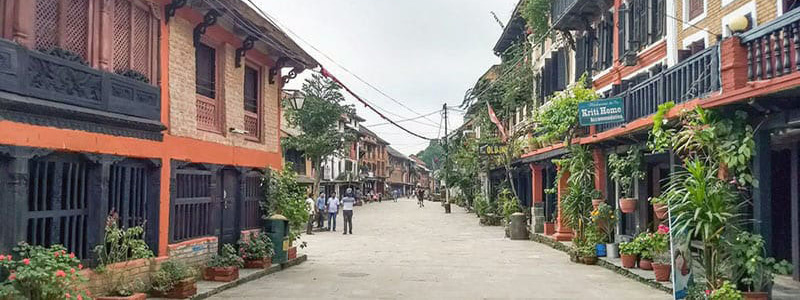
Bandipur: is a medieval town situated halfway between Kathmandu, the capital city and Pokhara. Bandipur is a modern day town with its old antique cultural atmosphere still intact. Bandipur is situated at 1030 m above sea level, and overlooks the Marsyangdi River Valley. The town was once a prosperous trading center. Bandipur was settled by Newars from Bhaktapurin the early nineteenth century. Later it is developed into an important stop along the India-Tibet trade route. The Bhaktapur Newar settlers had brought their rich cultural heritage and architecture to Bandipur.
Places of interest: Bazaar, Tudikhel, Shiddha Cave (largest in the Himalayas), etc.
Access: Half an hour drive from the Prithvi highway between Kathmandu and Pokhara.

Bandipur: ist eine mittelalterliche Stadt auf halber Strecke zwischen Kathmandu, der Hauptstadt, und Pokhara. Bandipur ist eine moderne Stadt mit ihrer alten, antiken kulturellen Atmosphäre intakt. Bandipur liegt auf 1030 m über dem Meeresspiegel und überblickt das Marsyangdi-Flusstal. Die Stadt war einst ein wohlhabendes Handelszentrum. Bandipur wurde von Newars besiedelt von Bhaktapurin im frühen neunzehnten Jahrhundert. Später entwickelte es sich zu einer wichtigen Station entlang der Handelsroute Indien-Tibet. Die Siedler von Bhaktapur Newar hatten ihr reiches kulturelles Erbe mitgebracht Kulturerbe und Architektur nach Bandipur.
Sehenswürdigkeiten: Basar, Tudikhel, Shiddha-Höhle (größte im Himalaya) usw.
Zufahrt: Eine halbe Autostunde von der Prithvi-Autobahn zwischen Kathmandu und Pokhara entfernt.

Bandipur: es una ciudad medieval situada a medio camino entre Katmandú, la capital, y Pokhara. Bandipur es una ciudad moderna que conserva intacto su antiguo ambiente cultural. Bandipur está situada a 1030 m sobre el nivel del mar y domina el valle del río Marsyangdi. La ciudad fue en su día un próspero centro comercial. Bandipur fue colonizada por newars de Bhaktapur a principios del siglo XIX. Más tarde se convirtió en una importante parada en la ruta comercial India-Tíbet. Los colonos newars de Bhaktapur trajeron a Bandipur su rico patrimonio cultural y su arquitectura. patrimonio cultural y arquitectónico a Bandipur.
Sitios de interés: Bazaar, Tudikhel, Cueva de Shiddha (la más grande del Himalaya), etc.
Acceso: A media hora en coche de la autopista Prithvi entre Katmandú y Pokhara.

Bandipur: è una cittadina medievale situata a metà strada tra Kathmandu, la capitale, e Pokhara. Bandipur è una città moderna con ancora la sua antica atmosfera culturale intatto. Bandipur è situata a 1.030 m sul livello del mare e si affaccia sulla valle del fiume Marsyangdi. La città un tempo era un prospero centro commerciale. Bandipur fu colonizzata da Newars da Bhaktapurin all'inizio del XIX secolo. Successivamente si trasformò in un'importante tappa lungo la rotta commerciale India-Tibet. I coloni Bhaktapur Newar avevano portato la loro ricca cultura patrimonio e architettura a Bandipur.
Luoghi di interesse: Bazaar, Tudikhel, Grotta di Shiddha (la più grande dell'Himalaya), ecc.
Accesso: a mezz'ora di auto dall'autostrada Prithvi tra Kathmandu e Pokhara.
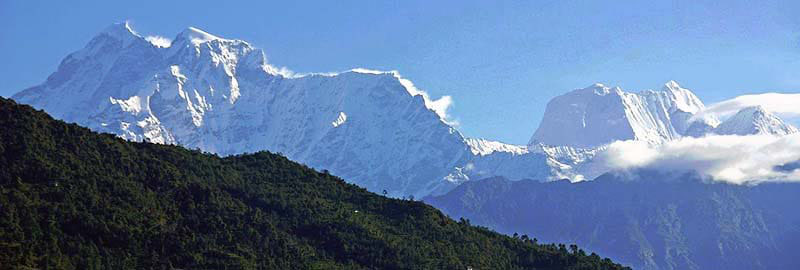
Dolakha: is a small medieval town in the east of Kathmandu with the Mt. Gaurishankar in the background Himalaya. Dolakha used to be an important town in the trade route to Lhasa, Tibet. The Bhimeshwar temple is located in Dolakha Bazar. The main statue featured in the temple is the second Pandav Bhimsen. The statue is known to sweat. The sweating of the idol is considered to be a bad omen for the head of the Nepal Government and to the people if it sweats on the left side. Dolakha is also a starting point of various off beaten trekking destinations including Rolwaling.
Places of interest: Bhimsen temple, Dolakha bazaar, holy Mt. Gaurishankar darshan, temples in the vicinity are Kalinchwok Temple, Kali Temple, Tripurasundari, etc.
Access: 4-5 hour drive from Kathmandu.

Dolakha: ist eine kleine mittelalterliche Stadt im Osten von Kathmandu mit dem Berg Gaurishankar im Himalaya im Hintergrund. Dolakha war einst eine wichtige Stadt auf der Handelsroute nach Lhasa, Tibet. Der Bhimeshwar-Tempel befindet sich im Dolakha Bazar. Die Hauptstatue im Tempel ist der zweite Pandav Bhimsen. Es ist bekannt, dass die Statue schwitzt. Das Schwitzen von Das Idol gilt als schlechtes Omen für den nepalesischen Regierungschef und das Volk, wenn es auf der linken Seite schwitzt. Dolakha ist auch ein Ausgangspunkt für verschiedene ausgetretene Pfade Trekkingziele einschließlich Rolwaling.
Sehenswürdigkeiten: Bhimsen-Tempel, Dolakha-Basar, heiliger Berg Gaurishankar Darshan, Tempel in der Nähe sind der Kalinchwok-Tempel, Kali-Tempel, Tripurasundari usw.
Anfahrt: 4–5 Stunden Fahrt von Kathmandu entfernt.

Dolakha: es una pequeña ciudad medieval al este de Katmandú con el monte Gaurishankar al fondo del Himalaya. Dolakha solía ser una ciudad importante en la ruta comercial a Lhasa, Tíbet. El templo Bhimeshwar está ubicado en Dolakha Bazar. La estatua principal que se encuentra en el templo es el segundo Pandav Bhimsen. Se sabe que la estatua suda. El sudor del ídolo se considera un mal augurio para el jefe del gobierno de Nepal y para el pueblo si suda del lado izquierdo. Dolakha también es un punto de partida de varios destinos de senderismo poco conocidos, incluido Rolwaling.
Sitios de interés: El templo Bhimsen, el bazar Dolakha, el monte sagrado Gaurishankar darshan, los templos en los alrededores son el templo Kalinchwok, Templo de Kali, Tripurasundari, etc.
Acceso: 4-5 horas en coche desde Katmandú.

Dolakha: è una piccola città medievale a est di Kathmandu con il monte Gaurishankar sullo sfondo dell'Himalaya. Dolakha era una città importante sulla rotta commerciale verso Lhasa, Tibet. Il tempio Bhimeshwar si trova a Dolakha Bazar. La statua principale presente nel tempio è il secondo Pandav Bhimsen. È noto che la statua suda. La sudorazione di l'idolo è considerato di cattivo auspicio per il capo del governo nepalese e per il popolo se suda sul lato sinistro. Dolakha è anche il punto di partenza di varie località fuori mano destinazioni di trekking tra cui Rolwaling.
Luoghi di interesse: tempio Bhimsen, bazar Dolakha, sacro monte Gaurishankar darshan, i templi nelle vicinanze sono il tempio Kalinchwok, Tempio di Kali, Tripurasundari, ecc.
Accesso: 4-5 ore di auto da Kathmandu.
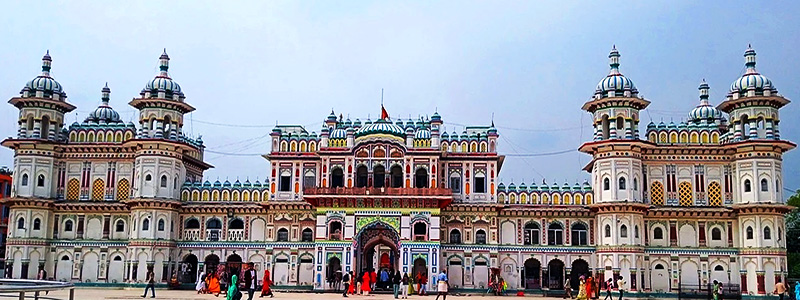
Janakpur: Nepal has a plain terrain along the India/Nepal border. The land is best known in Nepal as Madhes. Janakpur is in mid-Terai and is famous Hindu pilgrimage site. Janakpur is best known as the birthplace of Janaki Sita. Janaki Sita was married to Lord Ram in the era of the epic Ramayana. Janakpur and around is also known as Mithila. The folk art from that region is famously known as Mithila art.
Places of interest: Janaki Temple, Bibaha Mandap, and numerous beautiful ponds, Mithila Art center.
Access: Jankapur is connected with Kathmandu by air and by road via Dhulikhel or via Mahendra highway. One day pilgrimage tour from Kathmandu by air is done easily.

Janakpur: Nepal hat ein flaches Gelände entlang der Grenze zwischen Indien und Nepal. Das Land ist in Nepal vor allem als Madhes bekannt. Janakpur liegt in der Mitte von Terai und ist berühmte hinduistische Pilgerstätte. Janakpur ist vor allem als Geburtsort von Janaki Sita bekannt. Janaki Sita war in der Ära des epischen Ramayana mit Lord Ram verheiratet. Janakpur und Umgebung sind es auch bekannt als Mithila. Die Volkskunst aus dieser Region ist bekannt als Mithila-Kunst.
Sehenswürdigkeiten: Janaki-Tempel, Bibaha Mandap und zahlreiche schöne Teiche, Mithila Art Center.
Zugang: Jankapur ist per Flugzeug und auf der Straße über Dhulikhel oder über die Mahendra-Autobahn mit Kathmandu verbunden. Eine eintägige Pilgerreise von Kathmandu aus mit dem Flugzeug ist problemlos möglich.

Janakpur: Nepal tiene un terreno llano a lo largo de la frontera entre India y Nepal. La tierra es más conocida en Nepal como Madhes. Janakpur está en el centro de Terai y es un famoso lugar de peregrinación hindú. Janakpur es más conocido como el lugar de nacimiento de Janaki Sita. Janaki Sita se casó con Lord Ram en la era de la epopeya Ramayana. Janakpur y sus alrededores también se conocen como Mithila. El arte popular de esa región es famoso como arte Mithila.
Sitios de interés: Templo Janaki, Bibaha Mandap, y numerosos estanques hermosos, Centro de arte Mithila.
Acceso: Jankapur está conectada con Katmandú por aire y por carretera a través de Dhulikhel o de la autopista Mahendra. Es fácil realizar una peregrinación de un día desde Katmandú por aire.

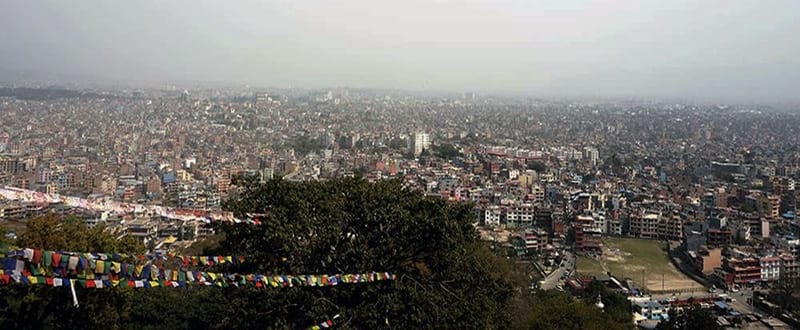
Kathmandu is a capital city of Republic of Nepal is in beautiful valley. The Kathmandu valley (1450 M) is famous for scenic beauty, beautiful countryside, ethnic settlements, and pilgrimages of holiest shrines for Hindus and Buddhists. Kathmandu valley has three regal cities called Kathmandu, Lalitpur (Patan), and Bhaktapur.
The countryside in the valley are cultural and heritage sites. Sankhu, Sundarijal, Changunarayan, Gokarna forest, Kirtipur, Bungmati village, Chapagaon and Bajra Barahi temple, Thimi, Chobhar, Dakhinakli Temple, Lele, etc. are famous destinations which are easily accessed by car.
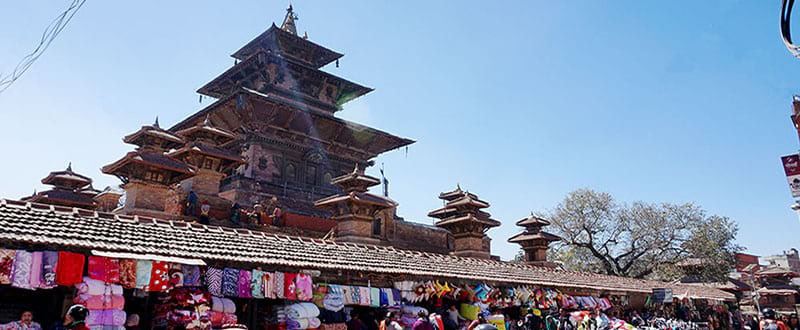
Kathmandu: Pashupatinath, Bouddhanath, Swoyambhunath, Kathmandudurbarsquare, Budhanilkantha, Balaju Water garden, Narayanhity Durbar Museum, etc.
Patan: Patandurbarsquare (Krishna Temple, Kumari chowk, etc.), Hiranyavarna Mahabihar, Kumbheswore Temple, Asoka Stupa, Tibetan Refugee Camp, etc.
Bhaktapur: Bhaktapurdurbarsquare, Golden Gate, Nyatpole Temple, Dattatreya Temple, Bhairavnath temple, Taumadi tol, etc. Kailashnath Mahadev Statue is the world's tallest Lord Shiva statue is another attraction which is placed in Sanga border with Kavrepalanchok.
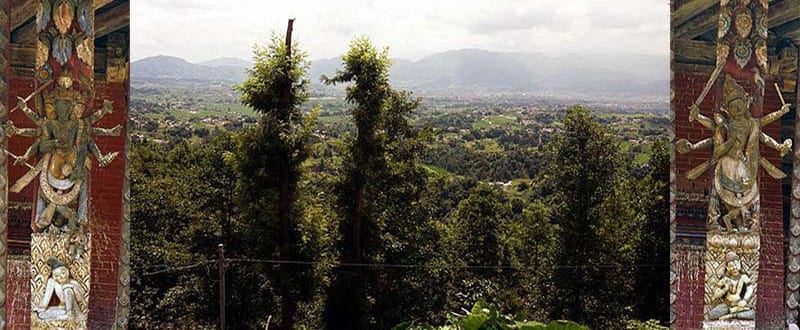
There are many resort towns on the rim of Kathmandu valley. Such resort sites are very panoramic and are best spots to see a large range of Himalayas and also the best point to witness Sunrise and Sunset. Nagarkot on the northeast rim is the most visited resort town in the rim of Kathmandu valley. Dhulikhel, Hatiban, and Daman are other famous resort towns in the rim of valley. A very old trading post, Chandragiri now a resort town, is on the southwest rim which is accessed by cable car from Thankot. Dhulikhel and Hatiban are famous for countryside tour. Daman has widest Mountain View. Such resort towns are best accessed by car. However one day or two days hiking in and around rim of the valley will give you a glimpse of trekking in Nepal.

Kathmandu ist eine Hauptstadt der Republik Nepal und liegt in einem wunderschönen Tal. Das Kathmandu-Tal (1450 m) ist berühmt für seine landschaftliche Schönheit, seine wunderschöne Landschaft, ethnische Siedlungen und Pilgerfahrten zu den heiligsten Schreinen für Hindus und Buddhisten. Das Kathmandu-Tal hat drei königliche Städte: Kathmandu, Lalitpur (Patan), und Bhaktapur.
Die Landschaft im Tal ist ein Kultur- und Kulturerbe. Sankhu, Sundarijal, Changunarayan, Gokarna-Wald, Kirtipur, Bungmati-Dorf, Chapagaon- und Bajra-Barahi-Tempel, Thimi, Chobhar, Dakhinakli-Tempel, Lele usw. sind berühmte Ziele, die leicht mit dem Auto zu erreichen sind.

Kathmandu: Pashupatinath, Bouddhanath, Swoyambhunath, Kathmandudurbarsquare, Budhanilkantha, Balaju-Wassergarten, Narayanhity Durbar Museum usw.
Patan: Patandurbarsquare (Krishna-Tempel, Kumari Chowk usw.), Hiranyavarna Mahabihar, Kumbheswore-Tempel, Asoka Stupa, tibetisches Flüchtlingslager usw.
Bhaktapur: Bhaktapurdurbarsquare, Golden Gate, Nyatpole-Tempel, Dattatreya-Tempel, Bhairavnath-Tempel, Taumadi Tol usw. Die Kailashnath Mahadev-Statue ist die weltweit größte Die höchste Statue von Lord Shiva ist eine weitere Attraktion, die an der Grenze von Sanga zu Kavrepalanchok steht.

Am Rande des Kathmandu-Tals gibt es viele Ferienorte. Solche Urlaubsorte bieten ein sehr panoramisches Panorama und sind die besten Orte zum Besichtigen große Auswahl an Himalaya-Bergen und auch der beste Punkt, um Sonnenauf- und -untergänge zu beobachten. Nagarkot am nordöstlichen Rand ist der meistbesuchte Ferienort am Rande des Kathmandu-Tals. Dhulikhel, Hatiban und Daman sind weitere berühmte Ferienorte am Rande des Tals. Ein sehr alter Handelsposten, Chandragiri, heute ein Ferienort, liegt am südwestlichen Rand Von Thankot aus mit der Seilbahn erreichbar. Dhulikhel und Hatiban sind berühmt für ihre Landtouren. Daman hat den breitesten Blick auf die Berge. Solche Ferienorte sind am besten mit dem Auto zu erreichen. Wenn Sie jedoch ein oder zwei Tage lang in und um den Talrand wandern, erhalten Sie einen Einblick in das Trekking in Nepal.

Katmandú, capital de la República de Nepal, se encuentra en un hermoso valle. El valle de Katmandú (1450 m) es famoso por su belleza paisajística, sus bellos paisajes, sus asentamientos étnicos y las peregrinaciones a los santuarios más sagrados para hindúes y budistas. El valle de Katmandú tiene tres ciudades regias llamadas Katmandú, Lalitpur (Patan) y Bhaktapur.
Los paisajes del valle son lugares de interés cultural y patrimonial. Sankhu, Sundarijal, Changunarayan, el bosque de Gokarna, Kirtipur, el pueblo de Bungmati, el templo de Chapagaon y Bajra Barahi, Thimi, Chobhar, el templo de Dakhinakli, Lele, etc. son destinos famosos a los que se puede acceder fácilmente en coche.

Katmandú: Pashupatinath, Bouddhanath, Swoyambhunath, Kathmandudurbarsquare, Budhanilkantha, Balaju Water garden, Narayanhity Durbar Museum, etc.
Patan: Patandurbarsquare (Krishna Temple, Kumari chowk, etc.), Hiranyavarna Mahabihar, Kumbheswore Temple, Asoka Stupa, Tibetan Refugee Camp, etc.
Bhaktapur: Bhaktapurdurbarsquare, Golden Gate, Nyatpole Temple, Dattatreya Temple, Bhairavnath temple, Taumadi tol, etc. La estatua de Kailashnath Mahadev, la más alta del mundo de Lord Shiva, es otra atracción que se encuentra en la frontera de Sanga con Kavrepalanchok.

Hay muchas ciudades turísticas en el borde del valle de Katmandú. Estos lugares son muy panorámicos y constituyen el mejor punto para contemplar una gran variedad del Himalaya, así como para presenciar el amanecer y el atardecer. Nagarkot, en el borde noreste, es la ciudad turística más visitada del valle de Katmandú. Dhulikhel, Hatiban y Daman son otras localidades turísticas famosas del valle. En el borde suroeste, al que se accede en teleférico desde Thankot, hay un antiguo puesto comercial, Chandragiri, que ahora es una ciudad turística. Dhulikhel y Hatiban son famosas por sus excursiones por el campo. Daman posee las vistas montañosas más amplias. A estas ciudades turísticas se accede mejor en coche. Sin embargo, uno o dos días de excursión por el valle y sus alrededores le permitirán hacerse una idea de lo que es el trekking en Nepal.

Kathmandu è la capitale della Repubblica del Nepal e si trova in una bellissima valle. La valle di Kathmandu (1450 M) è famosa per la bellezza paesaggistica, la bellissima campagna, insediamenti etnici e pellegrinaggi ai santuari più sacri per indù e buddisti. La valle di Kathmandu ha tre città regali chiamate Kathmandu, Lalitpur (Patan), e Bhaktapur.
Le campagne della valle sono siti culturali e del patrimonio. Sankhu, Sundarijal, Changunarayan, foresta di Gokarna, Kirtipur, villaggio di Bungmati, Il tempio Chapagaon e Bajra Barahi, Thimi, Chobhar, il tempio Dakhinakli, Lele, ecc. sono destinazioni famose facilmente accessibili in auto.
Kathmandu: Pashupatinath, Bouddhanath, Swoyambhunath, Kathmandu durbar square, Budhanilkantha, giardino acquatico Balaju, museo Narayanhity Durbar, ecc.

Kathmandu: Pashupatinath, Bouddhanath, Swoyambhunath, piazza Kathmandudurbar, Budhanilkantha, giardino acquatico Balaju, museo Narayanhity Durbar, ecc.
Patan: Patandurbarsquare (Tempio di Krishna, Kumari chowk, ecc.), Hiranyavarna Mahabihar, Tempio Kumbheswore, Asoka Stupa, Campo profughi tibetano, ecc.
Bhaktapur: piazza Bhaktapurdurbar, porta d'oro, tempio Nyatpole, tempio Dattatreya, tempio Bhairavnath, Taumadi tol, ecc. La statua di Kailashnath Mahadev è la statua più famosa del mondo la statua più alta del Signore Shiva è un'altra attrazione che si trova al confine di Sanga con Kavrepalanchok.

Ci sono molte località turistiche sul bordo della valle di Kathmandu. Tali siti di resort sono molto panoramici e sono i posti migliori per vedere a vasta gamma dell'Himalaya e anche il punto migliore per assistere all'alba e al tramonto. Nagarkot, sul bordo nord-orientale, è la località turistica più visitata sul bordo della valle di Kathmandu. Dhulikhel, Hatiban e Daman sono altre famose località turistiche sul bordo della valle. Una stazione commerciale molto antica, Chandragiri, ora una località turistica, si trova sul bordo sud-ovest accessibile tramite funivia da Thankot. Dhulikhel e Hatiban sono famosi per i tour in campagna. Daman ha la più ampia vista sulle montagne. È meglio raggiungere tali località turistiche in auto. Tuttavia, un giorno o due di escursioni all'interno e attorno al bordo della valle ti daranno un'idea del trekking in Nepal.
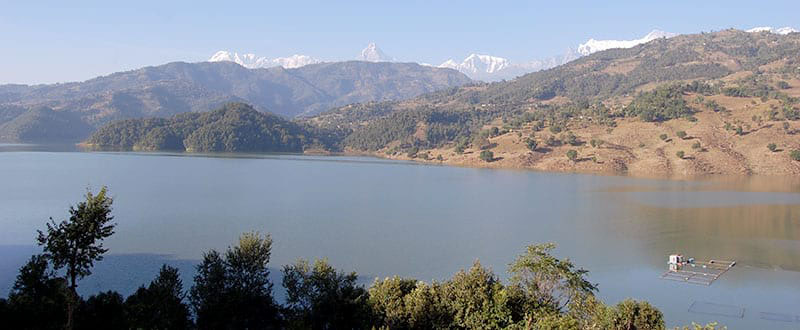
Pokhara valley (827 M) is 200 Km west of Kathmandu valley. Pokhara is the most popular destinations in Nepal after Kathmandu. Pokhara is a land of natural beauty with lakes and mountains. The valley is famous for lakes, snow capped mountains, beauty, and splendid panoramic scenes. Fewa, Rupa, and Begnash are beautiful lakes in Pokhara. The peaks of MT. Fish Tail and MT. Annapurna and Lake Fewa are the land mark of Pokhara. These splendid mountain peaks are very gorgeous. The reflection of MT. Machhapuchhre and MT. Annapurna on lake Fewa is very panoramic. You will have a very few words to describe the view of MT. Machhapuchhre on a clear full moon night.
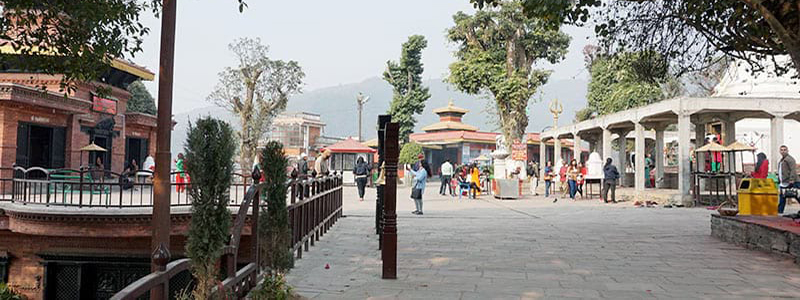
Places of Interest: Sheti Gorge, Davi's Fall, Mahendra Cave, Vindyavashini Temple, Barahi Temple, Fewa lake, Peace Stupa, Begnas Lake, Mountain Museum,
Sarangkot, Kaundanda, Naudanda, etc.
Lake Fewa: is the largest lake in Pokhara valley. You can enjoy water sports like swimming, boating, fishing, etc. in the lake. Temple Barahi, another
land mark of Pokhara, is a famous temple in the tiny island of the lake Fewa. Eastern bank of the lake, which is popularly known as Lakeside, is the main tourist
residence area in Pokhara with full of restaurants, souvenir shops, banks, etc.
Adventure in Pokhara: Paragliding, Ultra flight, Zip flyer, white water river rafting, hiking, etc.
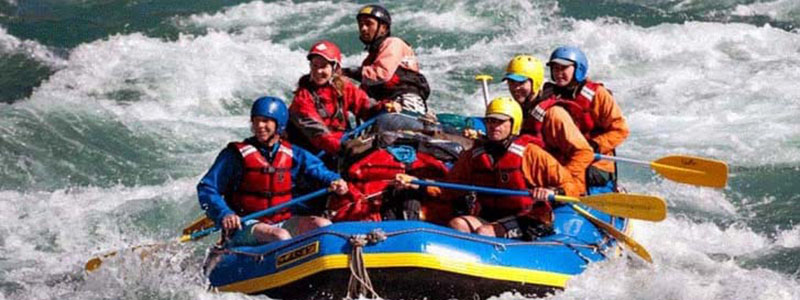
Access: Pokhara is well connected by road with Kathmandu, Chitwan, Lumbini and other parts of Nepal. You can also fly from Kathmandu to Pokhara which is also air linked to Jomsom. You can make journey to Pokhara more adventurous by white water river rafting in Trishuli river. Trishuli river is a river of rafting grade 2+ flows along Prithvi Highways to Pokhara. Moreover Pokhara is a gateway to Mustang including pilgrimage to Muktinath, Kagbeni, etc.
Pokhara is start and end point of most of the trekking in Annapurna and Dhoulagiri regions. There are also plenty of sites around Pokhara valley where a short trekking or a day hiking is enjoyed.

Das Pokhara-Tal (827 m) liegt 200 km westlich des Kathmandu-Tals. Pokhara ist nach Kathmandu das beliebteste Reiseziel in Nepal. Pokhara ist ein Land voller natürlicher Schönheit mit Seen und Bergen. Das Tal ist berühmt für seine Seen, schneebedeckten Berge, seine Schönheit und seine herrlichen Panoramaaussichten. Fewa, Rupa und Begnash sind wunderschöne Seen in Pokhara. Die Gipfel von MT. Fischschwanz und MT. Annapurna und der Fewa-See sind das Wahrzeichen von Pokhara. Diese herrlichen Berggipfel sind wirklich wunderschön. Die Reflexion von MT. Machhapuchhre und MT. Annapurna am Fewa-See bietet ein sehr panoramisches Panorama. Sie werden nur wenige Worte finden, um die Sichtweise von MT zu beschreiben. Machhapuchhre in einer klaren Vollmondnacht.

Sehenswürdigkeiten: Sheti-Schlucht, Davis-Fall, Mahendra-Höhle, Vindyavashini-Tempel, Barahi-Tempel, Fewa-See, Friedens-Stupa, Begnas-See, Bergmuseum,
Sarangkot, Kaundanda, Naudanda usw.
Fewa-See: ist der größte See im Pokhara-Tal. Im See können Sie Wassersportarten wie Schwimmen, Bootfahren, Angeln usw. nachgehen. Tempel Barahi, ein anderer
Das Wahrzeichen von Pokhara ist ein berühmter Tempel auf der winzigen Insel im Fewa-See. Das östliche Ufer des Sees, das im Volksmund als Lakeside bekannt ist, ist das Haupttouristenziel
Wohngegend in Pokhara mit zahlreichen Restaurants, Souvenirläden, Banken usw.
Abenteuer in Pokhara: Paragliding, Ultra-Flug, Zip-Flyer, Wildwasser-Rafting, Wandern usw.

Zugang:Pokhara ist über die Straße gut mit Kathmandu, Chitwan, Lumbini und anderen Teilen Nepals verbunden. Sie können auch von Kathmandu nach Pokhara fliegen von wo aus auch eine Flugverbindung nach Jomsom besteht. Sie können die Reise nach Pokhara durch Wildwasser-Rafting im Fluss Trishuli noch abenteuerlicher gestalten. Der Trishuli-Fluss ist ein Rafting-Fluss Klasse 2+ fließt entlang der Prithvi Highways nach Pokhara. Darüber hinaus ist Pokhara ein Tor nach Mustang, einschließlich Pilgerfahrten nach Muktinath, Kagbeni usw.
Pokhara ist Start- und Endpunkt der meisten Trekkings in den Regionen Annapurna und Dhoulagiri. Es gibt auch viele Orte rund um das Pokhara-Tal, wo u. a Genießen Sie kurze Trekkingtouren oder Tageswanderungen.

El valle de Pokhara (827 m) está a 200 km al oeste del valle de Katmandú. Pokhara es el destino más popular de Nepal después de Katmandú. Pokhara es una tierra de belleza natural con lagos y montañas. El valle es famoso por sus lagos, montañas nevadas, belleza y espléndidas escenas panorámicas. Fewa, Rupa y Begnash son hermosos lagos de Pokhara. Los picos de MT. Fish Tail y MT. Annapurna y el lago Fewa son la marca de la tierra de Pokhara. Estos espléndidos picos de montaña son muy hermosos. El reflejo de MT. Machhapuchhre y MT. Annapurna en el lago Fewa es muy panorámico. Usted tendrá muy pocas palabras para describir la vista de MT. Machhapuchhre en una noche clara de luna llena.

Lugares de interés: Desfiladero de Sheti, Cascada de Davi, Cueva de Mahendra, Templo de Vindyavashini, Templo de Barahi, Lago
Fewa, Estupa de la Paz, Lago Begnas, Museo de la Montaña, Sarangkot, Kaundanda, Naudanda, etc.
Lago Fewa: es el mayor lago del valle de Pokhara. En el lago se pueden practicar deportes acuáticos como natación, paseos en barca,
pesca, etc. Templo Barahi, otro marca de Pokhara, es un famoso templo en la pequeña isla del lago Fewa. La orilla oriental del lago,
conocida popularmente como Lakeside, es la principal zona de residencia de los turistas de Pokhara, llena de restaurantes, tiendas de
recuerdos, bancos, etc.
Aventura en Pokhara: Parapente, ultraligero, tirolina, rafting, senderismo, etc.

Accesos: Pokhara está bien comunicada por carretera con Katmandú, Chitwan, Lumbini y otras partes de Nepal. También se puede volar de Katmandú a Pokhara, que también está conectada por aire con Jomsom. Puede hacer que el viaje a Pokhara sea más aventurero haciendo rafting en el río Trishuli. El río Trishuli es un río de rafting de grado 2+ que fluye a lo largo de las autopistas Prithvi hasta Pokhara. Además, Pokhara es una puerta de entrada a Mustang, que incluye la peregrinación a Muktinath, Kagbeni, etc.
Pokhara es el punto de partida y de llegada de la mayoría de los trekkings en las regiones de Annapurna y Dhoulagiri. También hay muchos lugares alrededor del valle de Pokhara donde se puede disfrutar de un trekking corto o de un día de senderismo.

La valle di Pokhara (827 M) si trova a 200 km a ovest della valle di Kathmandu. Pokhara è la destinazione più popolare del Nepal dopo Kathmandu. Pokhara è una terra di bellezza naturale con laghi e montagne. La valle è famosa per i laghi, le montagne innevate, la bellezza e gli splendidi panorami. Fewa, Rupa e Begnash sono bellissimi laghi a Pokhara. Le cime del MT. Coda di pesce e MT. L'Annapurna e il Lago Fewa sono il punto di riferimento di Pokhara. Queste splendide cime montuose sono davvero stupende. Il riflesso di MT. Machhapuchhre e MT. L'Annapurna sul lago Fewa è molto panoramico. Avrai pochissime parole per descrivere la visione di MT. Machhapuchhre in una chiara notte di luna piena.

Luoghi di interesse: Gola di Sheti, Cascata di Davi, Grotta di Mahendra, Tempio Vindyavashini, Tempio Barahi, Lago Fewa, Stupa della pace, Lago Begnas, Museo della montagna,
Sarangkot, Kaundanda, Naudanda, ecc.
Lago Fewa: è il lago più grande della valle di Pokhara. Nel lago è possibile praticare sport acquatici come nuoto, canottaggio, pesca, ecc. Tempio Barahi, un altro
punto di riferimento di Pokhara, è un famoso tempio nella piccola isola del lago Fewa. La sponda orientale del lago, popolarmente conosciuta come Lakeside, è la principale meta turistica
zona residenziale a Pokhara piena di ristoranti, negozi di souvenir, banche, ecc.
Avventura a Pokhara: Parapendio, Volo Ultra, Zip flyer, rafting sulle rapide, escursioni, ecc.

Accesso: Pokhara è ben collegata tramite strada con Kathmandu, Chitwan, Lumbini e altre parti del Nepal. Puoi anche volare da Kathmandu a Pokhara che è anche collegato via aerea a Jomsom. Puoi rendere il viaggio a Pokhara più avventuroso facendo rafting sul fiume Trishuli. Il fiume Trishuli è un fiume di rafting il grado 2+ scorre lungo le autostrade Prithvi fino a Pokhara. Inoltre Pokhara è una porta d'accesso al Mustang, incluso il pellegrinaggio a Muktinath, Kagbeni, ecc.
Pokhara è il punto di partenza e di arrivo della maggior parte dei trekking nelle regioni dell'Annapurna e del Dhoulagiri. Ci sono anche molti siti intorno alla valle di Pokhara dove a è gradito un breve trekking o un'escursione di un giorno.

The Chitwan National Park (932 sq. km.) 200 Km south west of Kathmandu is the most visited WildLife Safari Park in Nepal. The National Park is the largest habitat
for Gaida (one horned rhinos) and is the second largest habitat for Royal Bengal Tigers in Nepal. Other wild animals are: wild elephants, deer, sloth bear, gaur (bovine),
wild boar, crocodiles (gharial and magars), leopards, langur monkey, and many more. Endangered Birds like giant hornbill, Bengal florican, black stork, white stork, etc.
are among 450 species of birds found in the park. It is a pride to mention here that Nepal becomes the first country to double the wild tiger population in Nepal.
National Park fee: Rs. 2000.00, Nepal: Rs. 150.00; SAARC: Rs. 1000.00
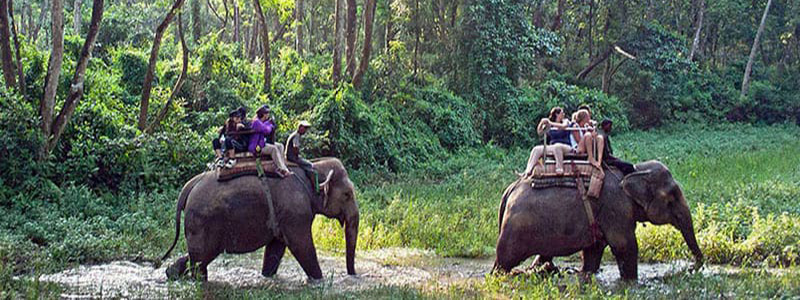
Village Sauraha is an old settlement of ethnic Tharu people. The village is in the buffer zone jungle of Chitwan National Park. The beach of River Rapti is a very popular spot in Sauraha. You can enjoy the best sunset view on a hot evening with a chilled drink.
Safari activities: You climb on an Elephant back, ride into the grassland which is as tall as an elephant and virgin forest of the Park to see Rhinos, tigers, and other wild animals. Plus: Jungle walks, Bird watching, Canoeing in a dug-out canoe, Visit to Elephant breeding center, etc.
Cultural: Tours in and around Tharu village and cultural programs performed by the ethnic Tharu communities. The Cultural variety includes famous stick dance and the dance with guests.
Additional: Jungle drive by Jeep (seasonal), visit to Crocodile breeding center, visit to the exotic Bis Hazari Taal (Twenty Thousand Lakes), and Devghat tour.

By air: Daily flights from Kathmandu to Bharatpur Airport duration about 25 minute; US$114.00 per person and hotel transfer from the Bharatpur airport costs
US$ 20.00 per person.
By Private vehicle: 4 Hours drive and you can enjoy en-route Cable Car ride to Mankamana Temple; from US$50.00 per person for a group of three; from Kathmandu
or Pokhara.
By Tourist bus: 5-6 hours cost US$8.00 to 15.00 per person; from Kathmandu or Pokhara
By white water river rafting: You can make journey to Chitwan National Park more adventurous by white water river rafting. You can enjoy river rafting in
Trishuli river (grade 2-3). The rafting trip in river Trishuli can be a trip of 1 to 2 days from Kathmandu. Or you can enjoy 2 days river rafting in
Sheti river (grade 2-3) if you are going from Pokhara.Costs: from US$ 35.00 per person per day.

Der Chitwan-Nationalpark (932 km²) 200 km südwestlich von Kathmandu ist der meistbesuchte Wildlife-Safaripark in Nepal. Der Nationalpark ist der größte Lebensraum
für Gaida (Einhornnashörner) und ist der zweitgrößte Lebensraum für Königstiger in Nepal. Andere wilde Tiere sind: wilde Elefanten, Hirsche, Lippenbären, Gaur (Rinder),
Wildschweine, Krokodile (Gavial und Magars), Leoparden, Languren und viele mehr. Gefährdete Vögel wie Riesennashornvogel, Bengalischer Florikan, Schwarzstorch, Weißstorch usw.
gehören zu den 450 Vogelarten, die im Park vorkommen. Wir sind stolz darauf, hier erwähnen zu können, dass Nepal das erste Land ist, das die wilde Tigerpopulation in Nepal verdoppelt hat.
Nationalparkgebühr: Rs. 2000,00, Nepal: Rs. 150,00; SAARC: Rs. 1000,00

Dorf Sauraha ist eine alte Siedlung des ethnischen Tharu-Volkes. Das Dorf liegt im Pufferzonen-Dschungel des Chitwan-Nationalparks. Der Strand des Flusses Rapti ist ein sehr beliebter Ort in Sauraha. An einem heißen Abend können Sie bei einem kühlen Getränk den besten Blick auf den Sonnenuntergang genießen.
Safari-Aktivitäten: Sie klettern auf den Rücken eines Elefanten, reiten in das Grasland, das so hoch wie ein Elefant ist, und in den Urwald des Parks, um Nashörner zu sehen. Tiger und andere wilde Tiere. Plus: Dschungelwanderungen, Vogelbeobachtung, Kanufahren in einem Einbaum, Besuch des Elefantenzuchtzentrums usw.
Kultur: Touren im und um das Tharu-Dorf und kulturelle Programme der ethnischen Tharu-Gemeinschaften. Die kulturelle Vielfalt umfasst den berühmten Stocktanz und der Tanz mit Gästen.
Zusätzlich: Dschungelfahrt mit dem Jeep (saisonal), Besuch des Krokodilzuchtzentrums, Besuch des exotischen Bis Hazari Taal (Zwanzigtausend Seen) und Devghat-Tour.

Mit dem Flugzeug:Tägliche Flüge von Kathmandu zum Flughafen Bharatpur, Dauer etwa 25 Minuten; Die Kosten für den Hoteltransfer vom Flughafen Bharatpur betragen 114,00 US-Dollar pro Person
20,00 US-Dollar pro Person.
Mit dem Privatfahrzeug: 4 Stunden Fahrt und unterwegs können Sie die Fahrt mit der Seilbahn zum Mankamana-Tempel genießen. ab 50,00 US-Dollar pro Person für eine Gruppe von drei Personen; aus Kathmandu
oder Pokhara.
Mit dem Touristenbus: 5–6 Stunden kosten 8,00 bis 15,00 US-Dollar pro Person; aus Kathmandu oder Pokhara
Mit Wildwasser-Rafting: Mit Wildwasser-Rafting können Sie die Reise zum Chitwan-Nationalpark noch abenteuerlicher gestalten. Hier können Sie River-Rafting genießen
Trishuli-Fluss (Klasse 2-3). Die Rafting-Tour auf dem Fluss Trishuli kann von Kathmandu aus ein ein- bis zweitägiger Ausflug sein. Oder Sie genießen zwei Tage Rafting auf dem Fluss
Sheti-Fluss (Stufe 2–3), wenn Sie von Pokhara aus reisen.Kosten: ab 35,00 US-Dollar pro Person und Tag.

El Parque Nacional de Chitwan (932 km2), a 200 km al suroeste de Katmandú, es el safari más visitado de Nepal. El Parque Nacional
es el mayor hábitat del Gaida (rinoceronte de un cuerno) y el segundo del Tigre Real de Bengala en Nepal. Otros animales salvajes son:
elefantes salvajes, ciervos, osos perezosos, gaur (bovinos), jabalíes, cocodrilos (gharial y magars), leopardos, monos langur y muchos más.
Aves en peligro de extinción como el cálao gigante, el florican de Bengala, la cigüeña negra, la cigüeña blanca, etc. son algunas de las
450 especies de aves que se encuentran en el parque. Es un orgullo mencionar aquí que Nepal se convierte en el primer país en duplicar la
población de tigres salvajes en Nepal.
Tasa del Parque Nacional: Rs. 2000.00, Nepal: Rs. 150.00; SAARC: Rs. 1000.00

Saurahaes un antiguo asentamiento de la etnia tharu. El pueblo se encuentra en la selva de la zona tampón del Parque Nacional de Chitwan. La playa del río Rapti es un lugar muy popular en Sauraha. Se puede disfrutar de la mejor vista del atardecer en una tarde calurosa con una bebida bien fría.
Actividades de safari: Se sube a lomos de un elefante, se adentra en la pradera que tiene la altura de un elefante y en la selva virgen del Parque para ver rinocerontes, tigres y otros animales salvajes. Además: Paseos por la selva, observación de aves, piragüismo en piragua, visita al centro de cría de elefantes, etc.
Cultural: Excursiones por el pueblo Tharu y sus alrededores y programas culturales interpretados por las comunidades étnicas Tharu. La variedad cultural incluye la famosa danza del palo y la danza con invitados.
Otros: Recorrido por la jungla en jeep (estacional), visita al centro de cría de cocodrilos, visita al exótico Bis Hazari Taal (Veinte mil lagos) y recorrido por Devghat.

En avión: Los vuelos diarios de Katmandú al aeropuerto de Bharatpur duran unos 25 minutos; 114,00 dólares por persona y el traslado al hotel desde el
aeropuerto de Bharatpur cuesta 20,00 dólares por persona.
En vehículo privado: 4 horas en coche y se puede disfrutar en ruta del teleférico al templo de Mankamana; desde 50,00 dólares por persona para un grupo
de tres; desde Katmandú o Pokhara.
En bus turístico: 5-6 horas cuestan entre 8,00 y 15,00 dólares por persona; desde Katmandú o Pokhara
En rafting por aguas bravas: Puede hacer que el viaje al Parque Nacional de Chitwan sea más aventurero practicando rafting en
aguas bravas. Puede disfrutar del rafting en río Trishuli (grado 2-3). El rafting en el río Trishuli puede ser un viaje de 1 a 2 días
desde Katmandú. O puede disfrutar de 2 días de rafting en el río río Sheti (grado 2-3) si vas desde Pokhara.Coste: a partir
de 35 dólares por persona y día.

Il Parco Nazionale di Chitwan (932 kmq) 200 km a sud-ovest di Kathmandu è il WildLife Safari Park più visitato del Nepal. Il Parco Nazionale è l'habitat più grande
per Gaida (rinoceronte con un corno) ed è il secondo habitat più grande per le tigri reali del Bengala in Nepal. Altri animali selvatici sono: elefanti selvatici, cervi, orsi bradipi, gaur (bovini),
cinghiali, coccodrilli (gharial e magar), leopardi, langur e molti altri. Uccelli in via di estinzione come il bucero gigante, il floricano del Bengala, la cicogna nera, la cicogna bianca, ecc.
sono tra le 450 specie di uccelli presenti nel parco. È un orgoglio menzionare qui che il Nepal diventa il primo paese a raddoppiare la popolazione di tigri selvatiche in Nepal.
Tariffa per il Parco Nazionale: Rs. 2000,00, Nepal: Rs. 150,00; SAARC: Rs. 1000,00

Villaggio Sauraha è un antico insediamento di etnia Tharu. Il villaggio si trova nella giungla della zona cuscinetto del Parco Nazionale di Chitwan. La spiaggia del fiume Rapti è un luogo molto popolare a Sauraha. Puoi goderti la migliore vista del tramonto in una serata calda con una bibita fresca.
Attività safari: sali sul dorso di un elefante, cavalchi nella prateria alta quanto un elefante e nella foresta vergine del parco per vedere i rinoceronti, tigri e altri animali selvatici. Inoltre: passeggiate nella giungla, birdwatching, canoa in canoa scavata, visita al centro di allevamento di elefanti, ecc.
Culturale: tour all'interno e nei dintorni del villaggio Tharu e programmi culturali organizzati dalle comunità etniche Tharu. La varietà culturale comprende la famosa danza del bastone e il ballo con gli ospiti.
Aggiuntivo: Viaggio nella giungla in Jeep (stagionale), visita al centro di allevamento dei coccodrilli, visita all'esotico Bis Hazari Taal (ventimila laghi) e tour di Devghat.

In aereo: Voli giornalieri da Kathmandu all'aeroporto di Bharatpur, durata circa 25 minuti; Costi di US$ 114,00 a persona e trasferimento in hotel dall'aeroporto di Bharatpur
US $ 20,00 a persona.
Con veicolo privato: 4 ore di guida e puoi goderti un giro in funivia lungo il percorso fino al Tempio Mankamana; da US$50,00 a persona per un gruppo di tre persone; da Katmandu
o Pokhara.
In autobus turistico: 5-6 ore costano da US$ 8,00 a 15,00 a persona; da Kathmandu o Pokhara
Con il rafting sul fiume: puoi rendere il viaggio al Parco Nazionale di Chitwan più avventuroso facendo rafting sul fiume. Puoi goderti il rafting sul fiume
Fiume Trishuli (grado 2-3). Il viaggio di rafting nel fiume Trishuli può durare da 1 a 2 giorni da Kathmandu. Oppure puoi goderti 2 giorni di rafting sul fiume
Fiume Sheti (grado 2-3) se vai da Pokhara.Costi: da US$ 35,00 a persona al giorno.
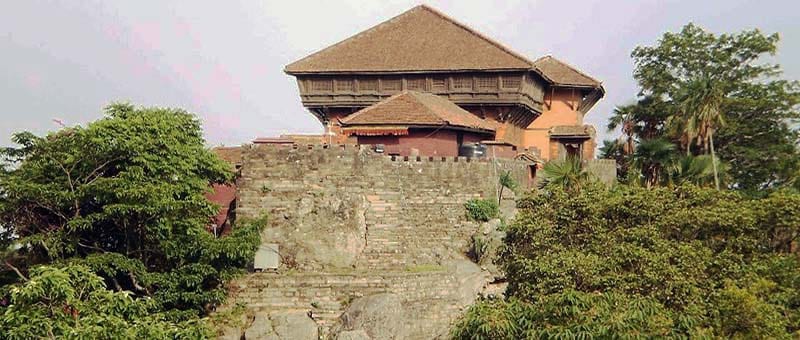
Gorkha is a mid-hill town lying in between Kathmandu and Pokhara. The Gurkhas legend begins from here. It was then from this very palace that the King Prithvi Narayan Shah began his campaign in the eighteenth century to unify the present day Nepal. The Gorkha town is on a hill. The beautiful Gorkha Durbar is on the top of a hill overlooking the snowy peaks of the Himalaya including the eighth highest peak Mt. Manaslu. The Gorkha Durbar is a fort with a palace and a temple complex.
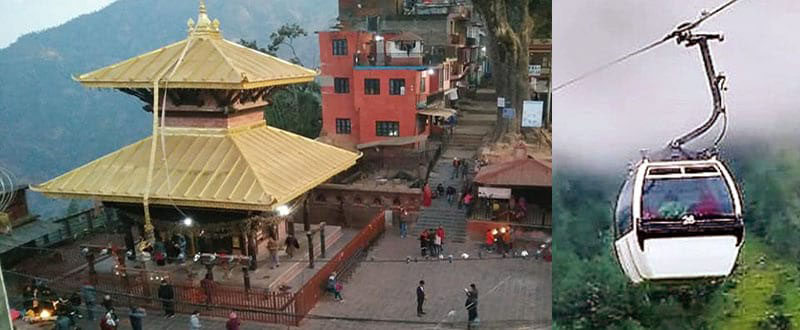
Manakamana: is on the top of a hill in Gorkha district. It is a scenic and pilgrim site. The Manakamana Temple is a famous temple where you can wish to fulfill your wishes.
Manakamana temple site is near to the Kuringhat which is on the highway half way between Kathmandu and Pokhara as well as between Kathmandu and Chitwan. From Kuringhat you do cable car
ride to Manakamana temple and back.
Access: The best access to Kuringhat is a car drive. Alternatively you can drive to Fisling, a put in point for the 3 hours white water river rafting in river Trishuli
with the put out point at Kuringhat.

Gorkha ist eine Bergstadt zwischen Kathmandu und Pokhara. Von hier aus beginnt die Gurkhas-Legende. Aus diesem Palast stammte damals der König Prithvi Narayan Shah begann seinen Feldzug im 18. Jahrhundert, um das heutige Nepal zu vereinen. Die Stadt Gorkha liegt auf einem Hügel. Das wunderschöne Gorkha Durbar liegt auf einem Hügel mit Blick auf die Stadt schneebedeckte Gipfel des Himalaya, einschließlich des achthöchsten Gipfels Mt. Manaslu. Die Gorkha Durbar ist eine Festung mit einem Palast und einer Tempelanlage.

Manakamana: liegt auf der Spitze eines Hügels im Bezirk Gorkha. Es ist ein malerischer und Pilgerort. Der Manakamana-Tempel ist ein berühmter Tempel, in dem Sie Ihre Wünsche erfüllen können.
Der Manakamana-Tempelstandort liegt in der Nähe des Kuringhat, der auf der Autobahn auf halber Strecke zwischen Kathmandu und Pokhara sowie zwischen Kathmandu und Chitwan liegt. Von Kuringhat aus fahren Sie mit der Seilbahn
Fahrt zum Manakamana-Tempel und zurück.
Anfahrt: Der beste Zugang nach Kuringhat ist eine Autofahrt. Alternativ können Sie nach Fisling fahren, einem Ausgangspunkt für das 3-stündige Wildwasser-Rafting im Fluss Trishuli
mit dem Ausstiegspunkt bei Kuringhat.

Gorkha es una ciudad de media montaña situada entre Katmandú y Pokhara. La leyenda de los gurkhas comienza aquí. Fue desde este mismo palacio desde donde el rey Prithvi Narayan Shah inició su campaña en el siglo XVIII para unificar el actual Nepal. La ciudad de Gorkha está en una colina. El hermoso Gorkha Durbar está en lo alto de una colina con vistas a los picos nevados del Himalaya, incluido el octavo pico más alto, el monte Manaslu. El Gorkha Durbar es un fuerte con un palacio y un complejo de templos.

Manakamana: está en la cima de una colina del distrito de Gorkha. Es un lugar pintoresco y de peregrinación. El templo de
Manakamana es un famoso templo donde se pueden pedir deseos. El templo de Manakamana está cerca de Kuringhat, que se encuentra en la
carretera a medio camino entre Katmandú y Pokhara, así como entre Katmandú y Chitwan. Desde Kuringhat se hace un viaje en teleférico
hasta el templo de Manakamana y vuelta.
Acceso: El mejor acceso a Kuringhat es en coche. También se puede ir en coche a Fisling, punto de llegada para el rafting de
3 horas en el río Trishuli, con punto de salida en Kuringhat.

Gorkha è una città di mezza collina situata tra Kathmandu e Pokhara. La leggenda dei Gurkha inizia da qui. Fu allora da questo stesso palazzo che il re Prithvi Narayan Shah iniziò la sua campagna nel XVIII secolo per unificare l'attuale Nepal. La città Gorkha è su una collina. La bellissima Gorkha Durbar si trova sulla cima di una collina che domina il cime innevate dell'Himalaya, inclusa l'ottava vetta più alta, il Monte Manaslu. Il Gorkha Durbar è un forte con un palazzo e un complesso di templi.

Manakamana: si trova sulla cima di una collina nel distretto di Gorkha. È un sito panoramico e di pellegrinaggio. Il Tempio Manakamana è un famoso tempio dove puoi desiderare di esaudire i tuoi desideri.
Il sito del tempio di Manakamana è vicino al Kuringhat che si trova sull'autostrada a metà strada tra Kathmandu e Pokhara, nonché tra Kathmandu e Chitwan. Da Kuringhat fai la funivia
giro al tempio di Manakamana e ritorno.
Accesso: il miglior accesso a Kuringhat è in auto. In alternativa puoi guidare fino a Fisling, un punto di riferimento per 3 ore di rafting sulle rapide del fiume Trishuli
con il punto di interruzione a Kuringhat.
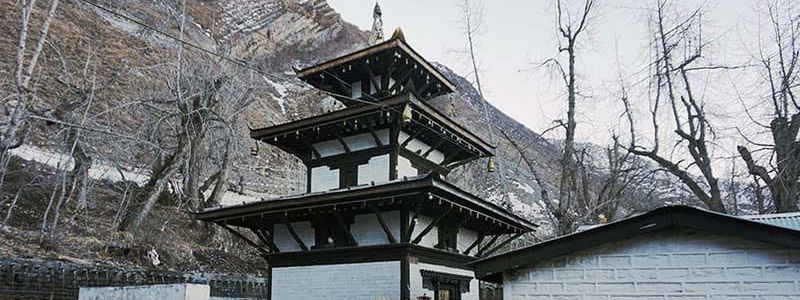
Muktinath: Muktinath temple is one of the holiest pilgrim destinations for devout Hindus. It is one of the 106th sacred Mukti Kshetra (assured of salvation) of 108 sacred places of Vaishnavs. This region is called Mukti Kshetra where Lord Vishnu got himself free from the curse of Sati. The Muktichhetra is also a Shaligram region. The Shaligrams are found along the Kaligandaki river. You can visit the largest Shaligram in this region. There is also a Jwaladevi, a divine flame, which is continuously burning for thousands of years in Muktinath Temple complex. The Muktinath temple is a pagoda shaped temple dedicated to Lord Vishnu. The temple site is at an altitude of 3800 m. The Muktinath Temple complex has 108 holy water spouts set on a wall for bath.
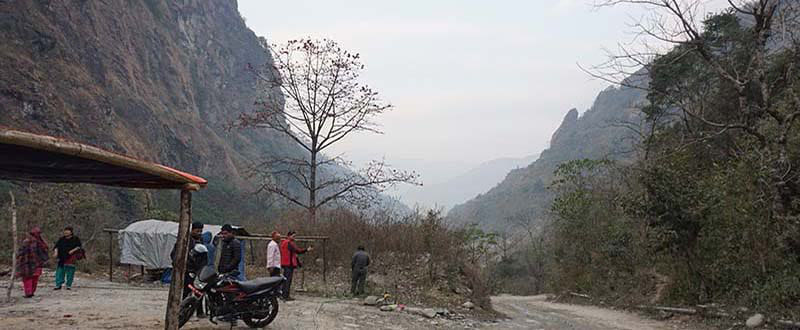
Access: Muktinath Temple is best accessed by air up to Jomsom and then Jeep drive to Muktinath Temple. The road between Beni and Muktinath is under construction. You can consider a bumpy ride to Muktinath from Pokhara in a bus or a jeep can be considered in a fair weather.
Permit and fee: TEAM: $10.00 per person; ACAP: Rs.2,000.00 person (Indian nationals: TEAM: Rs.300.00 per person; ACAP: Rs.300.00 person)

Muktinath: Der Muktinath-Tempel ist einer der heiligsten Pilgerziele für gläubige Hindus. Es ist eines der 106. heiligen Mukti Kshetra (Erlösungsgewisser) von 108 heiligen Orten der Vaishnavs. Diese Region heißt Mukti Kshetra, wo Lord Vishnu sich vom Fluch von Sati befreite. Das Muktichhetra ist auch eine Shaligram-Region. Die Shaligrams sind entlang des Kaligandaki-Flusses zu finden. Sie können das größte Shaligram in dieser Region besuchen. Es gibt auch ein Jwaladevi, eine göttliche Flamme, das seit Tausenden von Jahren ununterbrochen im Muktinath-Tempelkomplex brennt. Der Muktinath-Tempel ist ein pagodenförmiger Tempel, der Lord Vishnu gewidmet ist. Die Tempelanlage ist auf einer Höhe von 3800 m. Der Muktinath-Tempelkomplex verfügt über 108 an einer Wand angebrachte Weihwasserausläufe zum Baden.

Zugang:Der Muktinath-Tempel ist am besten mit dem Flugzeug bis nach Jomsom zu erreichen und dann mit dem Jeep zum Muktinath-Tempel zu fahren. Die Straße zwischen Beni und Muktinath ist im Bau. Sie können eine holprige Fahrt von Pokhara nach Muktinath mit dem Bus oder bei schönem Wetter mit einem Jeep in Betracht ziehen.
Genehmigung und Gebühr: TEAM: 10,00 $ pro Person; ACAP: 2.000,00 Rs. pro Person (indische Staatsangehörige: TEAM: 300,00 Rs. pro Person; ACAP: 300,00 Rs. pro Person)

Muktinath: El templo de Muktinath es uno de los destinos de peregrinación más sagrados para los devotos hindúes. Es uno de los 106 Mukti Kshetra sagrados (garantía de salvación) de los 108 lugares sagrados de los vaishnavs. Esta región recibe el nombre de Mukti Kshetra, donde el Señor Vishnu se liberó de la maldición de Sati. Muktichhetra es también una región de Shaligram. Los Shaligrams se encuentran a lo largo del río Kaligandaki. En esta región se puede visitar el Shaligram más grande. También hay una Jwaladevi, una llama divina, que arde continuamente desde hace miles de años en el complejo del templo de Muktinath. El templo de Muktinath tiene forma de pagoda y está dedicado al Señor Vishnu. El templo se encuentra a 3.800 m de altitud. El complejo del templo de Muktinath tiene 108 surtidores de agua bendita colocados en una pared para el baño.

Acceso: Al templo de Muktinath se accede mejor en avión hasta Jomsom y luego en jeep hasta el templo de Muktinath. La carretera entre Beni y Muktinath está en obras. Se puede considerar un viaje lleno de baches a Muktinath desde Pokhara en autobús o en jeep si hace buen tiempo.
Permiso y tasa: TEAM: $10.00 per person; ACAP: Rs.2,000.00 person (Indian nationals: TEAM: Rs.300.00 per person; ACAP: Rs.300.00 person)

Muktinath: il tempio di Muktinath è una delle destinazioni di pellegrinaggio più sacre per i devoti indù. È uno dei 106 sacri Mukti Kshetra (sicura della salvezza) di 108 luoghi sacri dei Vaisnav. Questa regione è chiamata Mukti Kshetra dove il Signore Vishnu si liberò dalla maledizione di Sati. Il Muktichhetra lo è anche una regione di Shaligram. Gli Shaligram si trovano lungo il fiume Kaligandaki. Puoi visitare il più grande Shaligram in questa regione. C'è anche una Jwaladevi, una fiamma divina, che brucia continuamente da migliaia di anni nel complesso del Tempio di Muktinath. Il tempio Muktinath è un tempio a forma di pagoda dedicato al Signore Vishnu. Il sito del tempio è ad un'altitudine di 3800 m. Il complesso del tempio di Muktinath ha 108 beccucci per l'acqua santa posizionati su un muro per il bagno.

Accesso: Il tempio di Muktinath è facilmente raggiungibile in aereo fino a Jomsom e poi in jeep fino al tempio di Muktinath. La strada tra Beni e Muktinath è in costruzione. Puoi prendere in considerazione un viaggio accidentato fino a Muktinath da Pokhara in autobus o una jeep con il bel tempo.
Permesso e tariffa: TEAM: $ 10,00 a persona; ACAP: Rs.2.000,00 a persona (cittadini indiani: TEAM: Rs.300,00 a persona; ACAP: Rs.300,00 a persona)
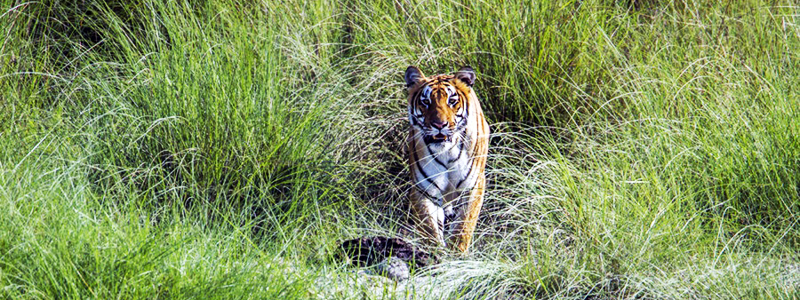
Bardiya National Park is the largest (968 square kilometers) and the least disturbed wild area in the west Terai. The national park is densely covered by Sal forests, reverie forests and grassland. The national park is the largest habitat of Royal Bengal tiger in Nepal. Within its confines there are animals such the rhinoceros, wild elephant, swamp deer, black buck, Gharial, wild boar, wild bison or Nilgai, and Gangetic dolphin. Endangered birds include the Bengal Florican, Lesser Florican, Silver- eared Mesia, and Sarus Crane. Over 30 different animals, 200 species of resident and migratory birds, including many reptiles and fish are found thriving in this wilderness.
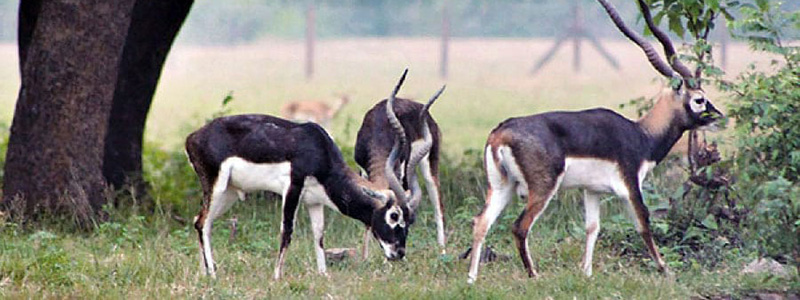
Jungle walk: To see Sal forest, open grassland, mammals and birds, and to track Tiger through their foot prints with the help of trackers.
Wait in machan: To see Bird, wild animals, and Royal Bengal Tiger (if lucky)
Elephant safari
White water river rafting: through rapids, to see hillside forests and deep jungle, birdwatching, sighting of Dolphins and crocodiles, etc.
Cultural program: The variety show by Tharu ethnics in their traditional colorful costumes.
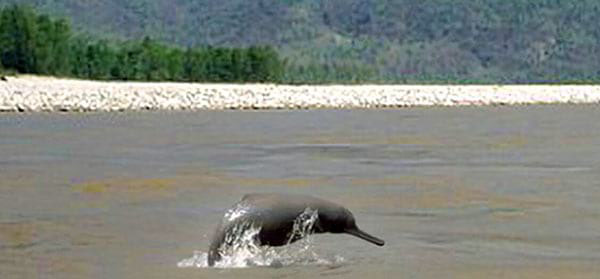
By surface: Drive 10 to 12 Hours by Private car or by local bus from Kathmandu; or 4-5 hours drive from Lumbini
By air: Fly 90 minutes to Nepalganj and then drive 3 - 4 hours to Thakurdwara

Der Bardiya-Nationalpark ist das größte (968 Quadratkilometer) und am wenigsten gestörte Wildgebiet im westlichen Terai. Der Nationalpark ist dicht von Sal-Wäldern bedeckt, Träumereiwälder und Grasland. Der Nationalpark ist der größte Lebensraum des Königstigers in Nepal. Innerhalb seiner Grenzen gibt es Tiere wie Nashörner, wilde Elefanten, Sumpfhirsch, Schwarzbock, Gavial, Wildschwein, Wildbison oder Nilgai und Gangesdelfin. Zu den vom Aussterben bedrohten Vögeln zählen der Bengalische Florikan, der Zwergflorikan, der Silberohr-Mesia und der Sarus-Kranich. In dieser Wildnis gedeihen über 30 verschiedene Tiere, 200 Arten von einheimischen Vögeln und Zugvögeln, darunter viele Reptilien und Fische.

Dschungelwanderung: Um den Sal-Wald, offenes Grasland, Säugetiere und Vögel zu sehen und mit Hilfe von Trackern Tiger anhand ihrer Fußabdrücke aufzuspüren.
Warten Sie in Machan: Um Vögel, wilde Tiere und den Königlichen Bengalischen Tiger zu sehen (wenn Sie Glück haben)
Elefantensafari
Wildwasser-Rafting: durch Stromschnellen, um Bergwälder und tiefen Dschungel zu sehen, Vogelbeobachtung, Sichtung von Delfinen und Krokodilen usw.
Kulturprogramm: Die Varieté-Show der Tharu-Volksgruppe in ihren traditionellen, farbenfrohen Kostümen.

An der Oberfläche: Fahren Sie 10 bis 12 Stunden mit dem Privatwagen oder dem örtlichen Bus von Kathmandu aus. oder 4-5 Stunden Fahrt von Lumbini
Mit dem Flugzeug: Fliegen Sie 90 Minuten nach Nepalganj und fahren Sie dann 3–4 Stunden nach Thakurdwara

El Parque Nacional de Bardiya es el mayor (968 kilómetros cuadrados) y la zona salvaje menos perturbada del Terai occidental. El parque nacional está densamente cubierto de bosques de sal, bosques de ensueño y praderas. El parque nacional es el mayor hábitat del tigre real de Bengala en Nepal. Dentro de sus confines hay animales como el rinoceronte, el elefante salvaje, el ciervo de los pantanos, el ciervo negro, el gavial, el jabalí, el bisonte salvaje o nilgai y el delfín del Ganges. Entre las aves en peligro figuran el florican de Bengala, el florican menor, la mesia de orejas plateadas y la grulla sarus. Más de 30 animales diferentes, 200 especies de aves residentes y migratorias, incluidos muchos reptiles y peces, prosperan en esta naturaleza salvaje.

Paseo por la selva: Para ver el bosque de Sal, praderas abiertas, mamíferos y aves, y rastrear al Tigre a través de sus huellas con la ayuda de rastreadores.
Espera en machan: Para ver aves, animales salvajes y el tigre real de Bengala (si tiene suerte)
Safari en elefante
Rafting en aguas bravas: a través de rápidos, para ver bosques de ladera y selva profunda, observación de aves, avistamiento de Delfines y cocodrilos, etc.
Programa cultural: Espectáculo de variedades de la etnia Tharu con sus coloridos trajes tradicionales.

En superficie: Viaje de 10 a 12 horas en coche privado o en autobús local desde Katmandú; o de 4 a 5 horas en coche desde Lumbini.
En avión: Vuelo de 90 minutos a Nepalganj y luego 3 - 4 horas en coche a Thakurdwara

Parco Nazionale Bardiya è l'area selvaggia più grande (968 chilometri quadrati) e meno disturbata del Terai occidentale. Il parco nazionale è densamente ricoperto da foreste di Sal, foreste e praterie da sogno. Il parco nazionale è il più grande habitat della tigre reale del Bengala in Nepal. All'interno dei suoi confini ci sono animali come il rinoceronte, l'elefante selvatico, cervo di palude, daino nero, gaviale, cinghiale, bisonte selvatico o Nilgai e delfino del Gange. Gli uccelli in via di estinzione includono il Florican del Bengala, il Florican minore, la Mesia dalle orecchie d'argento e la gru Sarus. In questa natura selvaggia prosperano oltre 30 animali diversi, 200 specie di uccelli stanziali e migratori, tra cui molti rettili e pesci.

Passeggiata nella giungla: per vedere la foresta di Sal, praterie aperte, mammiferi e uccelli e per seguire le impronte delle tigri con l'aiuto dei localizzatori.
Aspetta a Machan: per vedere l'uccello, gli animali selvatici e la tigre reale del Bengala (se fortunato)
Safari con gli elefanti
Rafting sul fiume: attraverso rapide, per vedere foreste collinari e giungla profonda, birdwatching, avvistamento di delfini e coccodrilli, ecc.
Programma culturale: lo spettacolo di varietà degli etnici Tharu nei loro tradizionali costumi colorati.

In superficie: guida da 10 a 12 ore in auto privata o in autobus locale da Kathmandu; o 4-5 ore di auto da Lumbini
In aereo: vola per 90 minuti fino a Nepalganj e poi guida per 3-4 ore fino a Thakurdwara
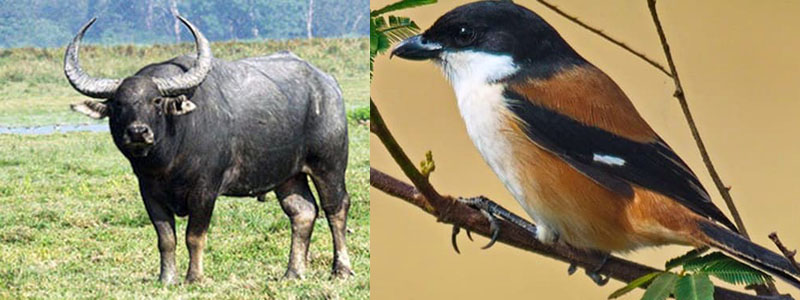
Koshi Tappu Wildlife Reserve, with an area of 175 square kilometers, is situated in the embankments of the Sapta Koshi river system. The vegetation consists mainly of grassland, scrub and deciduous forests. This reserve is unique for its 100 or so surviving wild water buffaloes. Other animals are the hog deer, wild boar, spotted, and the Gaur. The species of birds total 280 here and includes 20 of ducks, two of ibises, many storks, egrets, herons and the endangered swamp partridges and Bengal floricans. The region is a resting place for migrating birds not seen anywhere in Nepal. Endangered Gharial crocodiles and Gangetic dolphins are also sighted in the Koshi River.
Safari in Koshi Tappu Wildlife Reserve
Bird walk: in the marshland outside the reserve to see the storks, ibises, snipes, waterfowl etc.
Boat and 4WD for birdwatching in wetland and to see arnas (wild water buffalo), marsh crocodiles, and gangetic dolphins, etc.

Das Koshi Tappu Wildlife Reserve mit einer Fläche von 175 Quadratkilometern liegt an den Ufern des Sapta Koshi-Flusssystems. Die Vegetation besteht hauptsächlich aus Grasland, Busch- und Laubwälder. Dieses Reservat ist wegen seiner etwa 100 überlebenden Wildwasserbüffel einzigartig. Andere Tiere sind das Schwein, das Wildschwein, das Gefleckte und das Wildschwein Gaur. Insgesamt gibt es hier 280 Vogelarten, darunter 20 Enten, zwei Ibisse, viele Störche, Reiher, Reiher und die vom Aussterben bedrohten Sumpf-Rebhühner und bengalischen Florikaner. Der Die Region ist ein Rastplatz für Zugvögel, die nirgendwo in Nepal zu sehen sind. Im Koshi-Fluss werden auch vom Aussterben bedrohte Gavial-Krokodile und Ganges-Delfine gesichtet.
Safari im Koshi Tappu Wildlife Reserve
Vogelwanderung: im Marschland außerhalb des Reservats, um Störche, Ibisse, Bekassinen, Wasservögel usw. zu beobachten.
Boot und Geländewagen zur Vogelbeobachtung in Feuchtgebieten und zur Beobachtung von Arnas (wilden Wasserbüffeln), Sumpfkrokodilen und Gangesdelfinen usw.

Koshi Tappu Wildlife Reserve, with an area of 175 square kilometers, is situated in the embankments of the Sapta Koshi river system. The vegetation consists mainly of grassland, scrub and deciduous forests. This reserve is unique for its 100 or so surviving wild water buffaloes. Other animals are the hog deer, wild boar, spotted, and the Gaur. The species of birds total 280 here and includes 20 of ducks, two of ibises, many storks, egrets, herons and the endangered swamp partridges and Bengal floricans. The region is a resting place for migrating birds not seen anywhere in Nepal. Endangered Gharial crocodiles and Gangetic dolphins are also sighted in the Koshi River.
Safari in Koshi Tappu Wildlife Reserve
Bird walk: in the marshland outside the reserve to see the storks, ibises, snipes, waterfowl etc.
Boat and 4WD for birdwatching in wetland and to see arnas (wild water buffalo), marsh crocodiles, and gangetic dolphins, etc.

La Riserva naturale di Koshi Tappu, con un'area di 175 chilometri quadrati, è situata negli argini del sistema fluviale Sapta Koshi. La vegetazione è costituita principalmente da praterie, macchia e foreste decidue. Questa riserva è unica per i suoi circa 100 bufali d'acqua selvatici sopravvissuti. Altri animali sono il cervo porco, il cinghiale maculato e il Gaur. Qui le specie di uccelli ammontano a 280 e comprendono 20 anatre, due ibis, molte cicogne, garzette, aironi e le pernici di palude e le floricane del Bengala in via di estinzione. IL La regione è un luogo di riposo per gli uccelli migratori che non si vedono da nessuna parte in Nepal. Nel fiume Koshi vengono avvistati anche coccodrilli gaviali e delfini del Gange in via di estinzione.
Safari nella riserva naturale di Koshi Tappu
Passeggiata con gli uccelli: nella zona paludosa fuori dalla riserva per vedere cicogne, ibis, beccaccini, uccelli acquatici ecc.
Barca e fuoristrada per il birdwatching nelle zone umide e per vedere arna (bufali selvatici), coccodrilli di palude e delfini gangetici, ecc.
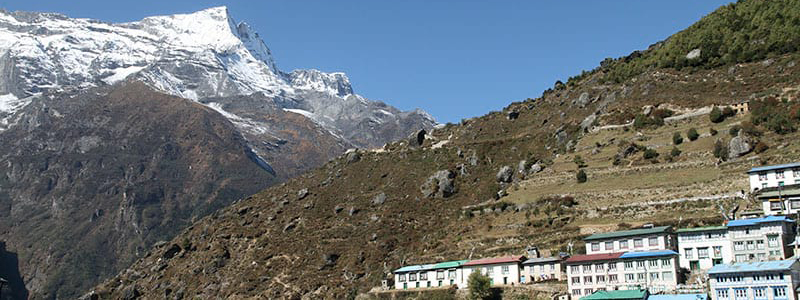
Mt. Everest National Park: Sagarmatha National Park is highest surface on Earth and has Highest peak popularly known as Mt. Everest (8,848 m).
Namche Bazaar is the Sherpa settlement at the base of Mt. Everest. It is a focal point of the trekking in Mt. Everest region.
Namche Bazaar is best accessed by air up to Lukla and then by 2 days trekking. The most popular trekking in Everest region are around Gokyo, Kalapattar, and Everest Base Camp.
For the trekking detail you can visit trekking in Nepal including trekking in Mt. Everest region.
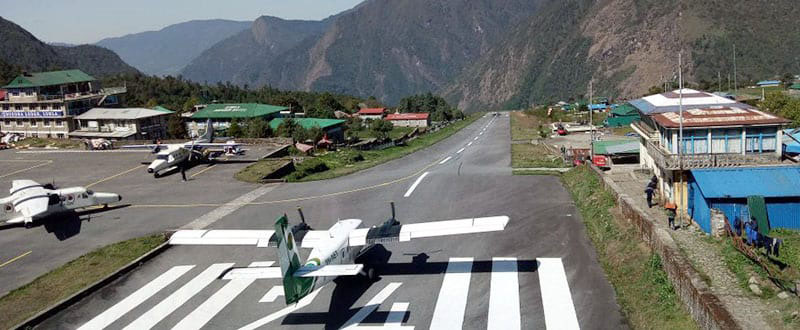
Access: Fly to Lukla and then two days trek to Namche Bazaar. Please note that the airport in Lukla is one of the most dangerous airports in the world. Alternatively you can drive to Salleri and then trek to Namche Bazaar. Please also note that the road to Salleri is a fair weather road.
Permit and fee: TEAM: $10.00 per person; Sagarmatha national park fee: Rs.3,390.00 per person; Indian national: TEAM: Rs.300.00 per person and Sagarmatha national park fee: Rs.1,500.00

Mt. Everest-Nationalpark: Der Sagarmatha-Nationalpark ist die höchste Fläche der Erde und hat den höchsten Gipfel, der im Volksmund als Mt. Everest bekannt ist (8.848 m).
Namche Bazaar ist die Sherpa-Siedlung am Fuße des Mount Everest. Es ist ein zentraler Punkt des Trekkings in der Mt. Everest-Region.
Namche Bazaar ist am besten per Flugzeug bis nach Lukla und dann über eine zweitägige Wanderung zu erreichen. Die beliebtesten Trekkingtouren in der Everest-Region finden rund um Gokyo, Kalapattar und das Everest-Basislager statt.
Einzelheiten zum Trekking finden Sie unter Trekking in Nepal, einschließlich Trekking in der Mt.-Everest-Region.

Zugang:Flug nach Lukla und dann zweitägige Wanderung nach Namche Bazaar. Bitte beachten Sie, dass der Flughafen in Lukla einer der gefährlichsten Flughäfen der Welt ist. Alternativ können Sie nach Salleri fahren und dann nach Namche Bazaar wandern. Bitte beachten Sie auch, dass die Straße nach Salleri eine Schönwetterstraße ist.
Genehmigung und Gebühr: TEAM: 10,00 $ pro Person; Gebühr für den Sagarmatha-Nationalpark: 3.390,00 Rs. pro Person; Indischer Staatsangehöriger: TEAM: 300,00 Rs. pro Person und Gebühr für den Sagarmatha-Nationalpark: 1.500,00 Rs.

Mt. Everest National Park: El Parque Nacional de Sagarmatha es la superficie más alta de la Tierra y tiene
el pico más alto conocido popularmente como el Everest (8.848 m). Namche Bazaar es el asentamiento sherpa en la base del Everest. Es un
punto neurálgico del trekking en la región del Everest.
Namche Bazaar: la mejor forma de llegar es en avión hasta Lukla y después hacer un trekking de dos días. Los trekking más populares
en la región del Everest son los de Gokyo, Kalapattar y el Campo Base del Everest. Para conocer los detalles del trekking, puede visitar
trekking en Nepal, incluido el trekking en la región del Everest.

Acceso: Vuelo a Lukla y luego dos días de trekking hasta Namche Bazaar. Tenga en cuenta que el aeropuerto de Lukla es uno de los más peligrosos del mundo. También se puede ir en coche a Salleri y luego caminar hasta Namche Bazaar. También hay que tener en cuenta que la carretera a Salleri es de buen firme.
Permiso y tasa: TEAM: $10.00 por persona; tasa del parque nacional de Sagarmatha: Rs.3,390.00 por persona; nacional indio: TEAM: Rs.300.00 por persona and tasa del parque nacional de Sagarmatha: Rs.1,500.00 por persona

Mt. Parco nazionale dell'Everest: Il Parco nazionale di Sagarmatha è la superficie più alta della Terra e ha la vetta più alta popolarmente conosciuta come Monte Everest (8.848 m).
Namche Bazaar è l'insediamento Sherpa alla base del Monte Everest. È un punto focale del trekking nella regione del Monte Everest.
Namche Bazaar è facilmente raggiungibile in aereo fino a Lukla e poi con un trekking di 2 giorni. I trekking più popolari nella regione dell'Everest sono intorno a Gokyo, Kalapattar e al campo base dell'Everest.
Per i dettagli sul trekking puoi visitare il trekking in Nepal, incluso il trekking nella regione del Monte Everest.

Accesso: Vola a Lukla e poi due giorni di cammino fino a Namche Bazaar. Tieni presente che l'aeroporto di Lukla è uno degli aeroporti più pericolosi al mondo. In alternativa puoi guidare fino a Salleri e poi camminare fino a Namche Bazaar. Tieni inoltre presente che la strada per Salleri è una strada con bel tempo.
Permesso e tariffa: TEAM: $ 10,00 a persona; Tariffa per il parco nazionale di Sagarmatha: Rs.3.390,00 a persona; Nazionale indiano: TEAM: Rs.300,00 a persona e quota per il parco nazionale di Sagarmatha: Rs.1.500,00
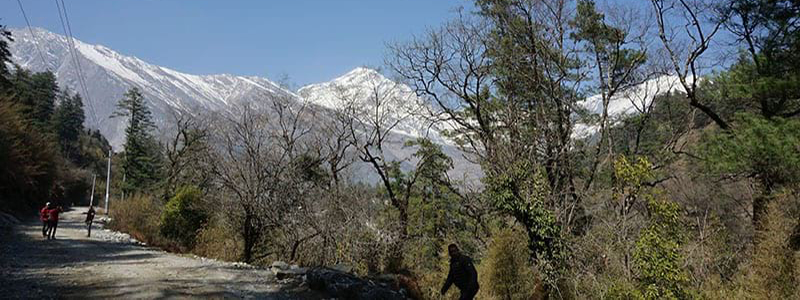
Annapurna National Park is in most scenic and panoramic range of Nepalese Himalayas. The National Park boundary starts from Rim of Pokhara valley to border with Tibet
in the north. The tourism in and around Annapurna National Park is most successful Eco-Tourism in the world. For the trekking detail you can visit Trekking in the
Annapurna region.
Mustang: The trail of Kaligandaki river take us to deepest Gorge in the world and then to a valley known as Mustang. You can take a bus or 4WD trip in a fair weather road along
Kaligandaki river. You can also fly to Jomsom in Mustang. Please note that any tour from Pokhara to Mustang is a journey of a Trans-Himalayan tour. Muktinath temple is the most visted
Hindu pilgrimage destination in Mustang
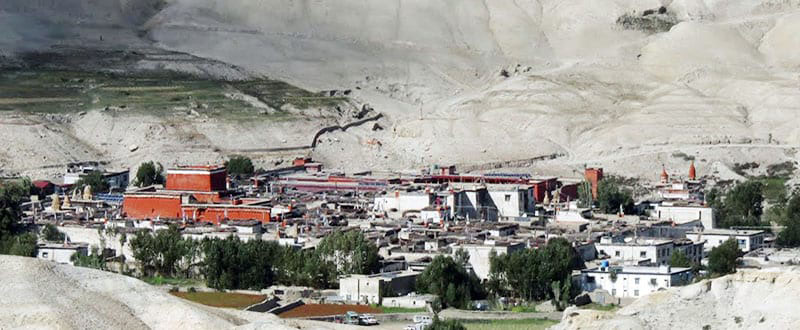
Lo Manthang: The upper reach of the Kaligandaki valley is known as Upper Mustang which is made a "Forbidden land". Lo Manthang is a walled capital of the Kingdom of Lo
since its founding by Ame Pal in 1380 AD. Ame Pal constructed the 6 meter high mud wall in the city. Many of the structures are still-standing. It is an important destination in
the upper Mustang. A journey from Jomsom to Lo Manthang is a walk along the ancient trading caravan route between Tibet and India.
Damodar Kund is another important destination in the upper Mustang for Hindu pilgrimage. The pilgrimage to Damodar Kund is a life time pilgrimage to Lord Vishnu.
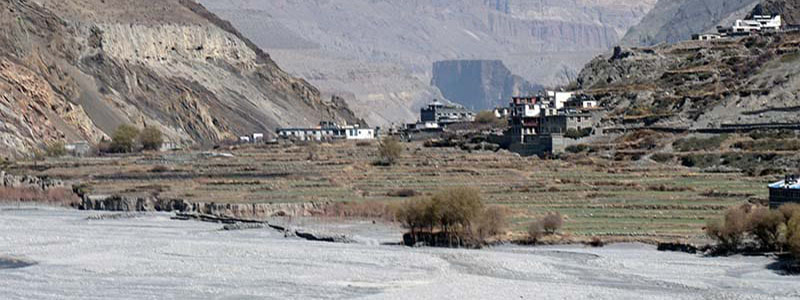
Accesso: Drive or Fly to Jomosm and then Jeep drive to Lomanathang from Jomsom via Kagbeni
Permesso e tariffa: TEAM: $10.00 per person; ACAP: Rs.2,000.00 person (Indian nationals: TEAM: Rs.300.00 per person; ACAP: Rs.300.00 person)
Upper Mustang permit (additional): $500.00 per person for the first ten days and for more than 10 days $50.00 per person per day is applicable.

Der Annapurna-Nationalpark liegt im landschaftlich schönsten und panoramischsten Bereich des nepalesischen Himalaya. Die Grenze des Nationalparks beginnt am Rand des Pokhara-Tals und reicht bis zur Grenze zu Tibet
im Norden. Der Tourismus im und um den Annapurna-Nationalpark ist der erfolgreichste Ökotourismus der Welt. Einzelheiten zum Trekking finden Sie unter Trekking im
Annapurna-Region.
Mustang:Der Weg des Kaligandaki-Flusses führt uns zur tiefsten Schlucht der Welt und dann in ein Tal namens Mustang. Bei schönem Wetter können Sie mit dem Bus oder einem Geländewagen entlang der Straße fahren
Kaligandaki-Fluss. Sie können auch mit Mustang nach Jomsom fliegen. Bitte beachten Sie, dass es sich bei jeder Tour von Pokhara nach Mustang um eine Trans-Himalaya-Tour handelt. Der Muktinath-Tempel ist der meistbesuchte
Hinduistisches Pilgerziel in Mustang

Lo Manthang:Der Oberlauf des Kaligandaki-Tals ist als Upper Mustang bekannt und wurde zum „Verbotenen Land“ erklärt. Lo Manthang ist eine ummauerte Hauptstadt des Königreichs Lo
seit seiner Gründung durch Ame Pal im Jahr 1380 n. Chr. Ame Pal errichtete die 6 Meter hohe Lehmmauer in der Stadt. Viele der Bauwerke stehen noch. Es ist ein wichtiges Reiseziel in
der obere Mustang. Eine Reise von Jomsom nach Lo Manthang ist eine Wanderung entlang der alten Handelskarawanenroute zwischen Tibet und Indien.
Damodar Kund ist ein weiteres wichtiges Ziel für hinduistische Pilgerfahrten im oberen Mustang. Die Pilgerreise nach Damodar Kund ist eine lebenslange Pilgerreise zu Lord Vishnu.

Anfahrt: Fahren oder fliegen Sie nach Jomosm und fahren Sie dann mit dem Jeep von Jomsom über Kagbeni nach Lomanathang.
Genehmigung und Gebühr: TEAM: 10,00 $ pro Person; ACAP: 2.000,00 Rs. pro Person (indische Staatsangehörige: TEAM: 300,00 Rs. pro Person; ACAP: 300,00 Rs. pro Person)
Upper Mustang-Genehmigung (zusätzlich): 500,00 $ pro Person für die ersten zehn Tage und für mehr als 10 Tage fallen 50,00 $ pro Person und Tag an.

El Parque Nacional del Annapurna se encuentra en la cordillera más pintoresca y panorámica del Himalaya nepalí. El Parque Nacional se extiende desde el borde del valle de Pokhara hasta
la frontera con el Tíbet en el norte. El turismo en el Parque Nacional del Annapurna y sus alrededores es el más exitoso del mundo. Para más información sobre el trekking, visite Trekking en
la región del Annapurna.
Mustang: El sendero del río Kaligandaki nos lleva a la garganta más profunda del mundo y luego a un valle conocido como Mustang. Se puede hacer un viaje en autobús o en 4x4 por una
carretera con buen tiempo a lo largo del río Kaligandaki. También puede volar a Jomsom en Mustang. Tenga en cuenta que cualquier excursión de Pokhara a Mustang es un viaje transhimalayo. El templo
de Muktinath es el destino de peregrinación hindú más visitado de Mustang.

Lo Manthang: El tramo superior del valle de Kaligandaki se conoce como Alto Mustang, que se ha convertido en «tierra prohibida».
Lo Manthang es una capital amurallada del Reino de Lo desde su fundación por Ame Pal en 1380 d.C.. Ame Pal construyó en la ciudad un muro
de adobe de 6 metros de altura. Muchas de las estructuras siguen en pie. Es un destino importante en el alto Mustang. Un viaje de Jomsom a
Lo Manthang es un paseo por la antigua ruta de caravanas comerciales entre el Tíbet y la India.
Damodar Kund es otro destino importante en el alto Mustang para la peregrinación hindú. La peregrinación a Damodar Kund es una
peregrinación de por vida al Señor Vishnu.

Accesso: Drive or Fly to Jomosm and then Jeep drive to Lomanathang from Jomsom via Kagbeni
Permit and Fee: TEAM: $10.00 per person; ACAP: Rs.2,000.00 person (Indian nationals: TEAM: Rs.300.00 per person; ACAP: Rs.300.00 person)
Upper Mustang permit (additional): $500.00 per person for the first ten days and for more than 10 days $50.00 per person per day is applicable.
 Il
Il Parco Nazionale dell'Annapurna si trova nella zona più pittoresca e panoramica dell'Himalaya nepalese. Il confine del Parco Nazionale inizia dal bordo della valle di Pokhara fino al confine con il Tibet
nel nord. Il turismo all’interno e nei dintorni del Parco Nazionale dell’Annapurna è l’ecoturismo di maggior successo al mondo. Per il dettaglio del trekking potete visitare Trekking in the
Regione dell'Annapurna.
Mustang: Il sentiero del fiume Kaligandaki ci porta nella gola più profonda del mondo e poi in una valle conosciuta come Mustang. Puoi fare un viaggio in autobus o in fuoristrada su una strada con bel tempo
fiume Kaligandaki. Puoi anche volare a Jomsom nel Mustang. Tieni presente che qualsiasi tour da Pokhara a Mustang è un viaggio di un tour trans-himalayano. Il tempio Muktinath è il più visitato
Destinazione di pellegrinaggio indù nel Mustang

Lo Manthang: La parte superiore della valle Kaligandaki è conosciuta come Mustang superiore, che è diventata una "terra proibita". Lo Manthang è una capitale fortificata del Regno di Lo
sin dalla sua fondazione da parte di Ame Pal nel 1380 d.C. Ame Pal ha costruito il muro di fango alto 6 metri nella città. Molte delle strutture sono ancora in piedi. È una destinazione importante in
il Mustang superiore. Un viaggio da Jomsom a Lo Manthang è una passeggiata lungo l'antica via carovaniera commerciale tra il Tibet e l'India.
Damodar Kund è un'altra destinazione importante nell'alto Mustang per il pellegrinaggio indù. Il pellegrinaggio a Damodar Kund è un pellegrinaggio a vita al Signore Vishnu.

Accesso: in auto o in volo fino a Jomosm e poi in jeep fino a Lomanathang da Jomsom via Kagbeni
Permesso e tariffa: TEAM: $ 10,00 a persona; ACAP: Rs.2.000,00 a persona (cittadini indiani: TEAM: Rs.300,00 a persona; ACAP: Rs.300,00 a persona)
Permesso Upper Mustang (aggiuntivo): $ 500,00 a persona per i primi dieci giorni e per più di 10 giorni si applicano $ 50,00 a persona al giorno.
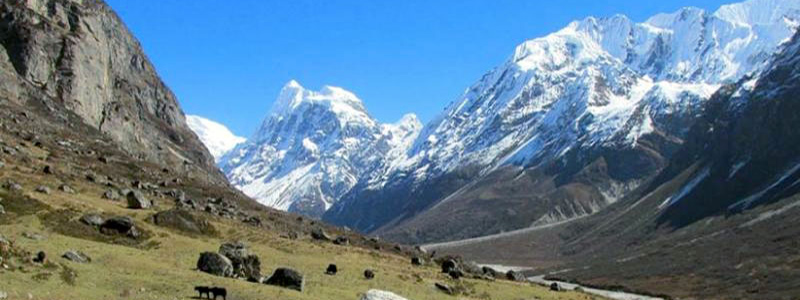
Langtang National Park is just 32 Km north of Kathmandu valley bordering Tibet in the north. The Langtang himalaya includes the famous peak Lakpa Dourje which can be seen from Kathmandu valley. The river Bhote Koshi is in the east and the river Trishuli is in the west Langtang. The national park is panoramic and is also best known for its flora and fauna including Red Pandas. Langtang National park has the closest and beautiful trekking destinations from Kathmandu. These include Langtang valley, holy Gosaikunda, Chisapani, Helambu valley, etc. The famous pilgrimage destination the Lake Gosaikunda is in the park at an elevation of 4,380 m (14,370 ft).
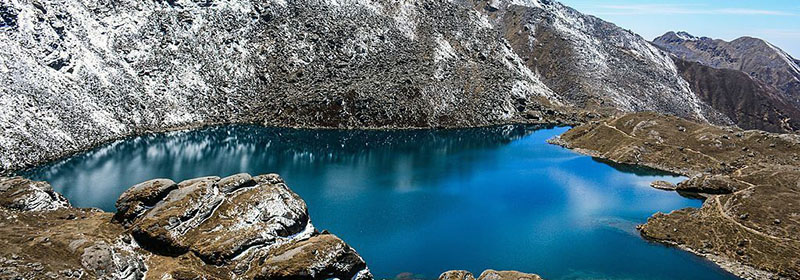
Gosaikunda: Gosaikunda is a glacier lake in Langtang. It is a one day drive from Kathmandu to Dhunche and then it is 2 to 3 days trekking. According to Puran lake Gosaikunda was created by Lord Shiva by his Trishul(Trident). He had to drink water after intake of Halahal or Kalkut poison. He has to digest the Kalkut poison which was the product obtained from Samudra Manthan by Gods and Ashurs. The most auspicious day for the Pilgrimage is Full moon day (Shrawan Purnima) in July. Many pilgrims from Nepal and India take a bath in the Lake. However, trekking to Gosaikunda is one of the most popular trekking in the Langtang region. Gosaikunda is also the source of River Trishuli.
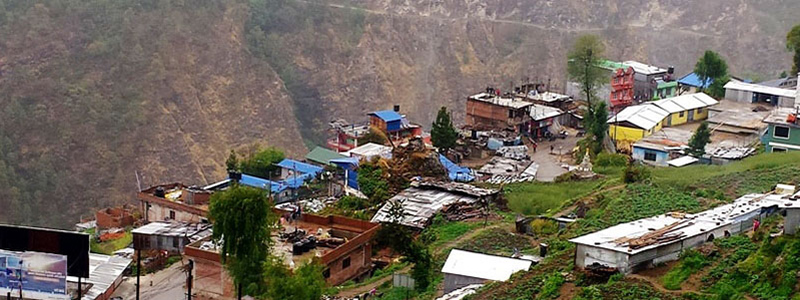
Access: Rasuwagadhi is now a transit point to Tibet. Hence road connections are made better from Kathmandu valley to and then to Rasuwagadhi. Further upgrading is continuing.

Der Langtang-Nationalpark liegt nur 32 km nördlich des Kathmandu-Tals und grenzt im Norden an Tibet. Der Langtang-Himalaya umfasst den berühmten Gipfel Lakpa Dourje, der zu sehen ist aus dem Kathmandutal. Der Fluss Bhote Koshi liegt im Osten und der Fluss Trishuli im Westen von Langtang. Der Nationalpark bietet ein Panorama und ist vor allem für seine Flora und Fauna bekannt darunter Rote Pandas. Der Langtang-Nationalpark bietet die nächstgelegenen und schönsten Trekkingziele von Kathmandu aus. Dazu gehören das Langtang-Tal, das heilige Gosaikunda, Chisapani, das Helambu-Tal, usw. Das berühmte Pilgerziel, der Gosaikunda-See, liegt im Park auf einer Höhe von 4.380 m (14.370 ft).


Zugang:Rasuwagadhi ist heute ein Transitpunkt nach Tibet. Dadurch werden die Straßenverbindungen vom Kathmandu-Tal nach Rasuwagadhi und dann nach Rasuwagadhi verbessert. Weitere Upgrades werden fortgesetzt.

Parque Nacional de Langtang está a sólo 32 km al norte del valle de Katmandú y limita al norte con el Tíbet. El Himalaya de Langtang incluye el famoso pico Lakpa Dourje, visible desde el valle de Katmandú. El río Bhote Koshi está al este y el río Trishuli al oeste de Langtang. El parque nacional es panorámico y también es conocido por su flora y fauna, incluidos los pandas rojos. El parque nacional de Langtang cuenta con los destinos de trekking más cercanos y hermosos desde Katmandú. Entre ellos están el valle de Langtang, el sagrado Gosaikunda, Chisapani, el valle de Helambu, etc. El famoso lago Gosaikunda, destino de peregrinación, se encuentra en el parque, a 4.380 m(14.370 ft). de altitud.

Gosaikunda: Gosaikunda es un lago glaciar en Langtang. Se tarda un día en coche desde Katmandú hasta Dhunche y luego se hace una caminata de dos a tres días. Según Puran, el lago Gosaikunda fue creado por el Señor Shiva con su Trishul (tridente). Tenía que beber agua después de ingerir el veneno Halahal o Kalkut. Tiene que digerir el veneno Kalkut, que era el producto obtenido del Samudra Manthan por los dioses y los Ashurs. El día más propicio para la peregrinación es el día de luna llena (Shrawan Purnima) en julio. Muchos peregrinos de Nepal y la India se bañan en el lago. Sin embargo, la caminata a Gosaikunda es una de las caminatas más populares en la región de Langtang. Gosaikunda es también la fuente del río Trishuli.

Acceso: Rasuwagadhi es ahora un punto de tránsito hacia el Tíbet. De ahí que se hayan mejorado las conexiones por carretera desde el valle de Katmandú hasta Rasuwagadhi. La mejora continúa.

Il Parco Nazionale Langtang si trova a soli 32 km a nord della valle di Kathmandu, al confine settentrionale con il Tibet. Il Langtang Himalaya comprende il famoso picco Lakpa Dourje che può essere visto dalla valle di Kathmandu. Il fiume Bhote Koshi si trova a est e il fiume Trishuli si trova a ovest di Langtang. Il parco nazionale è panoramico ed è conosciuto soprattutto per la sua flora e fauna compresi i panda rossi. Il Parco Nazionale Langtang ha le destinazioni trekking più vicine e belle da Kathmandu. Questi includono la valle di Langtang, la sacra Gosaikunda, Chisapani, la valle di Helambu, ecc. La famosa meta di pellegrinaggio del Lago Gosaikunda si trova nel parco ad un'altitudine di 4.380 m (14.370 piedi).


Accesso: Rasuwagadhi è ora un punto di transito verso il Tibet. Quindi i collegamenti stradali sono migliorati dalla valle di Kathmandu a Rasuwagadhi e poi a Rasuwagadhi. Ulteriori aggiornamenti continuano.
The Hindu pilgrimages: There are mainly three kinds of Hindu Pilgrimages in Nepal and they are 1. Lord Shiva, 2. Lord Vishnu, and 3. Ma Shakti. According to Shiva Purana the Himalayas are the home of Lord Shiva and Parbati. Hence there are many Pilgrimage sites related to Lord Shiva in Nepal. Pashupatinath Temple is the Holiest pilgrim of Lord Shiva. Mt. Kailas is the mountain of Lord Shiva and it is considered the holiest of all holy mountains. Mt. Kailas is in Tibet near Nepal Tibet border. A mountain with a Temple on its top is also considered Holy Mountain. There are several Shakti-peeths related to Durga Ma throughout Nepal. Dakhinakli and Guheswori are the most famous Shakti-peeths of Kathmandu valley. Other important Shakti-peeths in Nepal are Pathibhara, Shaileswori, Vindhyavashini, Mankamana, Jogeshwori, etc. Such Shakti-peeths are usually situated on the top of a hill or a mountain.
The confluence of rivers, particularly when they are major tributaries of the Ganges, is always regarded as religiously significant by Hindus, as it is believed a third spiritual river also joins. Such a confluence is called Tribeni.
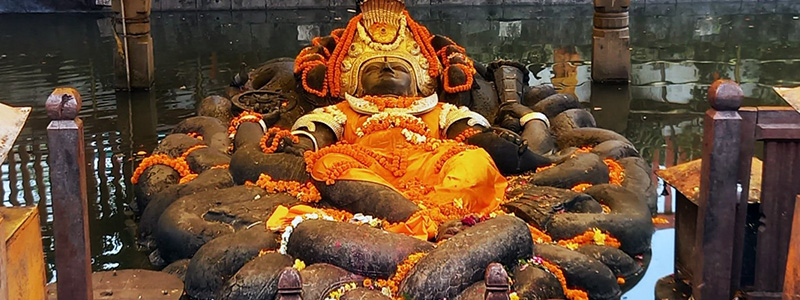
Pashupati: Lord Shiva is worshipped as Pashupati or Pashupatinath, the Lord of all living creatures. The temple of Pashupatinath is 6 Km east of Kathmandu. The site of Pashupatinath (Pashupat Kshetra) is one of the holiest places in Nepal for Hindus all over the world. Many Hindu Pilgrims come to Pashupatinath round the year. Hundreds of thousands of Hindu from all over the World make Pilgrimage on the day of Shivaratri (Night of Shiva in February). There are many temples of various Hindu Gods in the holy site. Guheswori temple is the most important among other temples. A walk from this temple to Aryaghat near Pashupatinath temple is very popular among non-Hindu tourists. Pashupatinath Temple area is one of the UNESCO World Heritage sites in Nepal. Entrance fee: Rs. 1,000.00; India: free
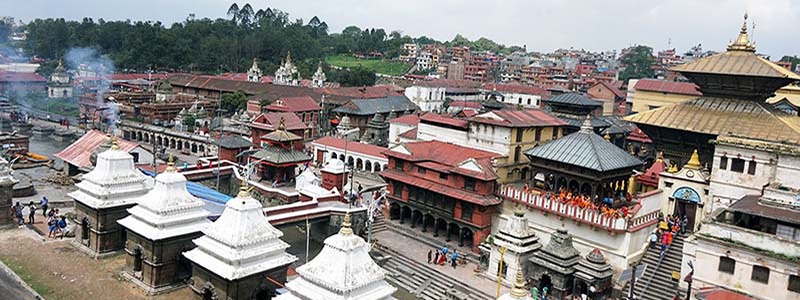
Janakpur: Nepal has a plain terrain along the India/Nepal border. The land is best known in Nepal as Madhes. Janakpur is in mid-Terai and is famous Hindu pilgrimage site. Janakpur is best known as the birthplace of Janaki Sita. Janaki Sita was married to Lord Ram in the era of the epic Ramayana. Janakpur and around is also known as Mithila. The folk art from that region is famously known as Mithila art.
Places of interest: Janaki Temple, Bibaha Mandap, and numerous beautiful ponds, Mithila Art center.
Access: Jankapur is connected with Kathmandu by air and by road via Dhulikhel or via Mahendra highway. One day pilgrimage tour from Kathmandu by air is done easily.

Gosaikunda: Gosaikunda is a glacier lake in Langtang. It is a one day drive from Kathmandu to Dhunche and then it is 2 to 3 days trekking. According to Puran lake Gosaikunda was created by Lord Shiva by his Trishul(Trident). He had to drink water after intake of Halahal or Kalkut poison. He has to digest the Kalkut poison which was the product obtained from Samudra Manthan by Gods and Ashurs. The most auspicious day for the Pilgrimage is Full moon day (Shrawan Purnima) in July. Many pilgrims from Nepal and India take a bath in the Lake. However, trekking to Gosaikunda is one of the most popular trekking in the Langtang region. Gosaikunda is also the source of River Trishuli.
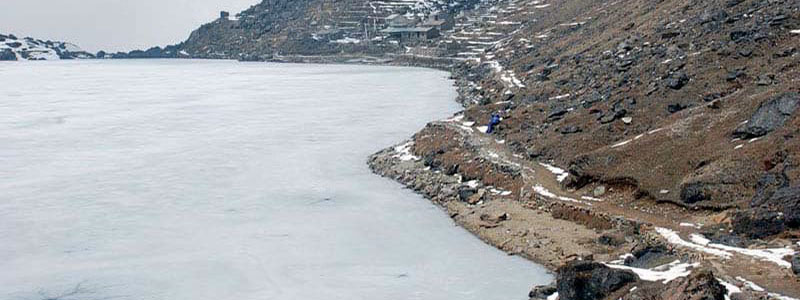
Muktinath: is one of the holiest pilgrimage destinations for devout Hindus. It is one of the 106th sacred Mukti Kshetra (assured of salvation) of 108 sacred places of Vaishnavs. This region is called Mukti Kshetra where Lord Vishnu got himself free from the curse of Sati. The Muktichhetra is also a Shaligram region. The Shaligrams are found along the Kaligandaki river. You can visit the largest Shaligram in this region. There is also a Jwaladevi, a divine flame, which has been continuously burning for thousands of years in the Muktinath Temple complex. The Muktinath temple is a pagoda-shaped temple dedicated to Lord Vishnu. The temple site is at an altitude of 3800 m. The Muktinath Temple complex has 108 holy water spouts set on a wall for baths.
Access: By air: Fly to Jomsom and the drive to Muktinath.
By Bus or car: Drive to Jomsom via Beni and then to Muktinath. Please note that the road from Beni to Jomsom is a fair weather road and hence you must expect a bumpy ride
Permit and fee: TEAM: $10.00 per person; ACAP: Rs 2000.00 person (Indian nationals: TEAM: Rs 300.00 per person; ACAP: Rs. 300.00 person)

Damodar Kund: is a glacier lake at the slope of Damodar Himal in Mustang. Damodar Kund is one of the most important pilgrimages to Lord Vishnu. The pilgrimage is parallel to Kailas pilgrimage for Lord Shiva. The Damodar lake is located three days walk north east of the main Mustang trekking route and very close to the border with Tibet. Damodar Kund is the source of River Kaligandaki. The site is in the region of Shaligram and hence it is also called Shalgrams. Other names of River Gandaki are Kaligandaki, Saptagandaki, and Narayani.
Access: Jeep drive to Lomanathang from Jomsom and then three days trek to Damodar Kund
Permit and fee: TEAM: $10.00 per person; ACAP: Rs 2000.00 person (Indian nationals: TEAM: Rs 300.00 per person; ACAP: Rs. 300.00 person)
Upper Mustang permit (additional): $500.00 per person for the first ten days and for more than 10 days $50.00 per person per day is
applicable.
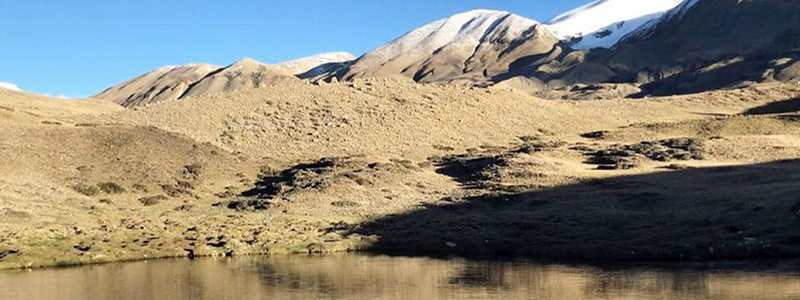
The Buddhist pilgrimages: Buddha was born in Nepal at Lumbini as Shiddarth Gautam. Shiddarth Gautam led the world on the path to enlightenment and became Lord Buddha two thousand five hundred years ago. He was born as a prince named Siddhartha Gautam. The birth site was then developed into a beautiful garden. The beautiful Garden in the Buddha's time still retains its legendary charm and beauty and remains in the present day Lumbini Garden. Lumbini is about 20 minute drive from Siddharthnagar, a town in mid western Nepal.
Places of interest: Maya Devi Temple (birth site), Asoka Pillar, Archeological excavation sites, various Buddhist temples and monasteries from Buddhist countries from all over worlds. Tilaurakot was the capital city in the Lord Buddha era. The archeological excavation around Tilaurakot is another attraction.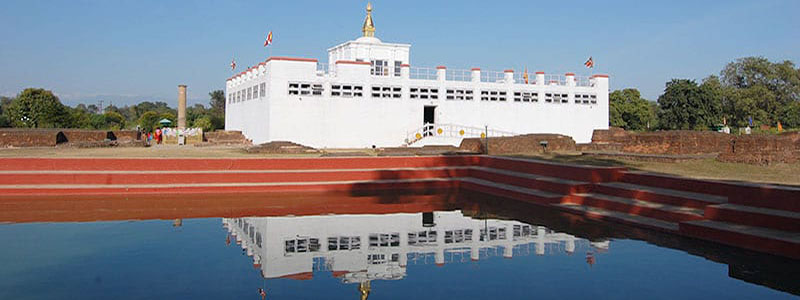
Namobuddha: Buddhist holy books narrate tales of several Buddhas before the arrival of Siddhartha Gautam Buddha, the Enlightened One. Namobuddha is the place where Lord Buddha, in an earlier life, offered his body to a starving tigress so she could feed her cubs. There is a small stupa built in reverence to the ultimate sacrifice of the Buddha. It is said that his hair, bones and so forth were made into a Stupa, the Stupa now known as Namobuddha. It is in the east of Kathmandu valley near Panauti, Kavrepalanchok district.
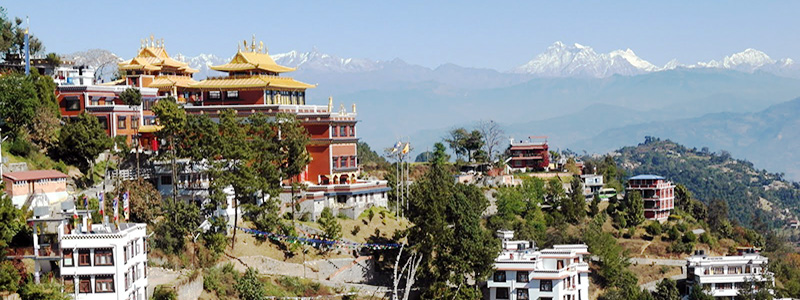
Some Buddhist pilgrimage sites: Important Buddhist Stupa in Kathmandu valley are four Stupa built by Asoka Emperor in Patan and one Chabhil, etc. There are several Tibetan monasteries around Kathmandu valley. Some of the monasteries were recently built. Monasteries at Kapan and Pharping are noticeably popular among tourists. Tengboche Monastery is the highest altitude monastery in the Everest region of Nepal.
